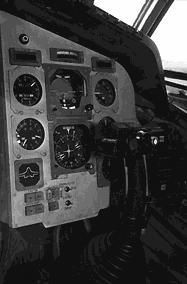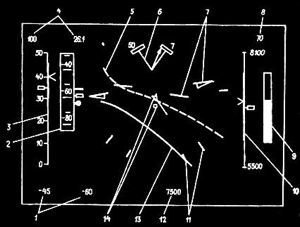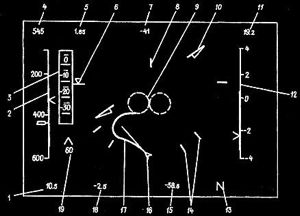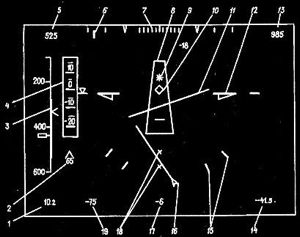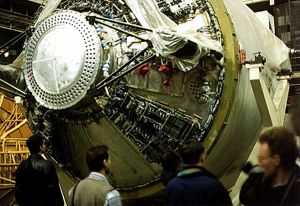
Home - Search - Browse - Alphabetic Index: 0- 1- 2- 3- 4- 5- 6- 7- 8- 9
A- B- C- D- E- F- G- H- I- J- K- L- M- N- O- P- Q- R- S- T- U- V- W- X- Y- Z
Buran
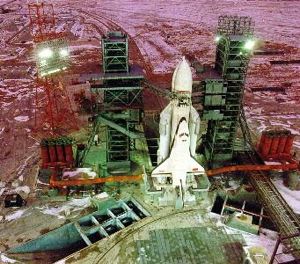 Buran on Pad Buran on Pad - 340 pixel width Credit: Dr.Vadim P.Lukashevich |
AKA: 11F35;11F36. Status: Operational 1988. First Launch: 1988-11-15. Last Launch: 1988-11-15. Number: 1 . Payload: 30,000 kg (66,000 lb). Thrust: 172.50 kN (38,780 lbf). Gross mass: 105,000 kg (231,000 lb). Unfuelled mass: 90,400 kg (199,200 lb). Specific impulse: 362 s. Height: 36.37 m (119.32 ft). Diameter: 2.40 m (7.80 ft). Span: 23.92 m (78.47 ft).
The Energia-Buran Reusable Space System (MKS) had its origins in NPO Energia studies of 1974 to 1975 for a 'Space Rocket Complex Program'. In 1974 the N1-L3 heavy lunar launch vehicle project was cancelled and Glushko was appointed chief designer of the new NPO Energia enterprise, replacing Mishin as the head of the former OKB-1. At the same time in the United States development work was underway on the space shuttle. The US Defence Department planned to use the shuttle for a range of military missions. The Soviet military, seeking strategic parity, wished development in the Soviet Union of a reusable manned spacecraft with analogous tactical-technical characteristics. The success of Apollo and the failure of the N1-L3 program pointed to serious deficiencies in the technology base of the Soviet Union. The time-honoured Soviet method of rectifying such situations was to copy the foreign technology.
To reduce development cost and risk, NASA and USAF shuttle trade studies had settled on a partially reusable design. While the solid propellant booster rockets were recovered, the cryogenic main propellant tank of the shuttle core was expendable. The main engines and guidance system were recovered with the orbiter.
The American shuttle design was studied intensively by Russian rocket scientists, but important aspects of it were rejected based on Soviet engineering analysis and technology:
The Soviet Union at this point had no experience in production of large solid rocket motors, especially segmented solid rocket motors of the type used on the shuttle. Glushko favoured a launch vehicle with parallel liquid propellant boosters. These would use a 700 tonne thrust four-chamber Lox/Kerosene engine already under development.
The high chamber pressure, closed-cycle, reusable 230 tonne thrust Lox/LH2 main engine being developed for the shuttle was well outside engineering experience in the Soviet Union. No engine using these cryogenic propellants had ever been used in Russian rockets, and the largest such engine under development was the 40 tonne thrust 11D57. Glushko believed that while a Soviet cryogenic engine of 200 tonnes thrust could be developed in the required time, to develop a reusable engine would be impossible due to limited experience with the propellants.
This conclusion led to other important design decisions. If only expendable engines were to be used, there was no need to house them in the re-entry vehicle for recovery. This meant that the orbiter itself could be moved from the lateral mounting of the space shuttle to an on-axis position at the top of the rocket core. The result was the Vulkan - a classic Soviet launch vehicle design: booster stages arranged around a core vehicle, with the payload mounted on top. The elimination of the lateral loads resulted in a lighter booster, and one that was much more flexible. The vehicle could be customised for a wide range of payloads by the use of from two to eight booster stages around a core equipped with from one to four modular main engines. Either a payload container for heavy payloads (Glushko's LEK lunar base) or the military's required spaceplane could be placed on the nose as the payload.
As far as the manned orbital vehicle itself, three different primary configurations were studied extensively, as well as a range of more radical proposals. The obvious choice was a straight aerodynamic copy of the US shuttle. The shuttle's form had been selected by NASA and the US Air Force only after painstaking iterative analysis of over 64 alternate configurations from 1968 to 1972. It would obviously benefit the Soviet engineers to take advantage of this tremendous amount of work.
However the NPO Energia specialists who had developed the Soyuz capsule disapproved of the winged US shuttle design. They knew from the extensive aerodynamic studies undertaken to develop Soyuz that there were large weight penalties and thermal control problems in any winged design. Their studies indicated that a lifting body shape capable of high angles of bank at hypersonic speed could nearly match winged designs in cross range. Therefore their preferred 1974 design was an unwinged spacecraft, consisting of a crew cabin in the forward conical section, a cylindrical payload section, and a final cylindrical section with the engines for manoeuvring in orbit. This unwinged MTKVA would glide to the landing zone at low subsonic speed. The final landing manoeuvre would use parachutes for initial braking, followed by a soft vertical landing on skid gear using retrorockets. After a great deal of detailed analysis the definitive MTKVA design proposed in May 1976 had a refined aerodynamic shape with a rounded triangular cross section. The 200 tonne vehicle had over twice the shuttle's mass and nearly three times the shuttle's payload.
The third configuration was a smaller spaceplane launched by a Proton-class booster. OKB MiG had been developing the Spiral lifting body spaceplane since 1965, but the project was underfunded and years behind schedule. Spiral was an ambitious concept that was to be launched by a hypersonic air breathing first stage. But the spaceplane itself had been refined in form as a result of years of analysis, wind tunnel, and sub-orbital sub-scale model tests. Chelomei's OKB, whose Raketoplan spaceplane had been cancelled in 1965 in preference to Spiral, also had a contender, the LKS. Evidently owing nothing to earlier Raketoplan designs, this used a shuttle-type wing on a smaller 20 tonne spacecraft.
The government decree 132-51 authorising development of the Energia-Buran system was issued on 12 February 1976 with the title 'On development of an MKS (reusable space system) consisting of rocket stages, orbiter aircraft, inter-orbital tug, guidance systems, launch and landing facilities, assembly and repair facilities, and other associated facilities, with the objective of placing in a 200 km Northeast orbit a payload of 30 tonnes and returning a payload of 20 tonnes'. The Ministry of Defence was named the Program Manager, with NPO Energia as the prime contractor. The official military specification (TTZ) was issued at the same time with the code name Buran. A declaration of the Presidium on 18 December 1976 directed co-operation between all concerned user, research, and factory organisations in realising the project. Chief Constructor within NPO Energia was I N Sadovskiy. Chief Designer for the launch vehicle was Y P Kolyako and for the orbiter P V Tsybin. NPO Yuzhnoye in the Ukraine would build the booster rockets. While NPO Energia would build the booster engines, the core Lox/LH2 engines would be built by Kosberg. Chelomei and MiG were to continue, at a modest level, design and test of their LKS and Spiral smaller spaceplanes as backups.
The specification of the TTZ set forth payload requirements a bit greater than those set for the US shuttle. It required that the OK orbiter be accomplish the following:
- Denial of the use of space for military purposes by the enemy
- Research into questions of interest to the military, science, and the national economy
- Applied military research and experiments using large space complexes
- Delivery to orbit and return to earth of spacecraft, cosmonauts, and supplies
- Delivery of 30 tonne payload to a 200 km, 50.7 degree inclination orbit, followed by seven days of orbital operations and return of 20 tonnes of payload to earth.
- Exploit the technology developed for the American space shuttle in order to enhance Soviet space technology capability
Therefore a straight aerodynamic copy of the US space shuttle, was selected as the orbiter configuration on 11 June 1976. MiG was selected as subcontractor to build the orbiter. For this purpose MiG spun off a new design bureau, Molniya, with G E Lozino-Lozinskiy as chief designer. Wind tunnel tests were conducted on a wide range of possible arrangements of rocket stages and orbiter positions. In the end, Buran was moved to the lateral position, as with the US space shuttle. The main engines, for the reasons given earlier, remained in the core vehicle. The liquid boosters were retained, but reduced to four in number. After being re-stressed for the lateral launch loads, the resulting Energia launch vehicle had half the lift-off mass and payload of the Vulkan. This was sufficient to carry the Buran with its required internal payload of 30 tonnes.
The MKS draft project was completed on 12 December 1976. The military assigned the system the index number 1K11K25 and the launch vehicle the article number 11K25. The draft project was reviewed by the expert commission in July 1977, leading to a government decree 1006-323 of 21 November 1977 setting out the development plan. The technical project was completed in May 1978. The flight test plan at the beginning of the project foresaw first launch of the booster in 1983, with the payload being an unmanned OK-ML-1 mock-up of the orbiter. This would not have a heat shield and remain attached to the booster. A second mock-up, OK-ML-2, would be used on the second launch, but be separated from the vehicle after burnout. However it would also be without heat shield, and be expended. The first flight Buran was to fly unpiloted in 1984. Manned flights were to be routine by the 1987 seventieth anniversary of the Soviet Union.
The approved launch vehicle layout consisted of the core Block Ts stage, surrounded by 4 Block A liquid propellant boosters and the Buran orbiter or a payload canister. During assembly, transport, and on the pad these were attached to a Block Ya launch services module, which provided all pneumatic, electrical, hydraulic, and other services to the vehicle prior to launch.
The modular Energia design could be used for payloads of from 10 to 200 tonnes using various combinations of booster stages, numbers of modular main engines in the core stage, and upper stages. The version with two booster stages was code-named Groza; with four booster stages, Buran; and the six-booster stage version retained the Vulkan name. The 7.7 meter diameter of the core was determined by the maximum size that could be handled by existing stage handling equipment developed for the N1 programme. The 3.9 meter diameter of the booster stages was dictated by the maximum size for rail transport from the Ukraine.
Propellant selection was a big controversy. Use of solid propellants in the booster stages, as used in the space shuttle, was considered again. But Soviet production of solid fuel motors had been limited to small unitary motors for ICBM's and SLBM's. There was no technological base for production of segmented solid fuel motors, and transport of the motor sections also presented problems. The final decision was to use the familiar Lox/Kerosene liquid propellants for the boosters. In the 1960's Glushko had favoured use of toxic but storable chemical propellants in launch vehicles and had fought bitterly against Korolev over the issue. It is surprising that he now accepted use of Lox/Kerosene. But Korolev was dead, and the N1 a failure. Glushko's position had been vindicated, perhaps he now had to agree objectively that use of the expensive and toxic propellants in a launch vehicle of this size was not rational.
Another factor may have been that the propellants of the core were going to be cryogenic anyway. Lox/Kerosene propellants for the core were considered, but a primary objective of the project was to seek technological parity with the United States by exploiting technologies developed there. Chief among these in the field of liquid fuel rocketry was the use of Lox/LH2 propellants. Therefore the engines of the core were based on the Space Shuttle Main Engine (SSME) of the USA, with the same thrust rating and specific impulse specifications.
Although the SSME may have been the starting point, Soviet engine technology led that of the United States in many other detailed points of liquid rocket design. By the mid-1960's the USA had practically abandoned development of liquid fuel engines, with the sole exception of the SSME. The US military preferred to use solid rocket motors for missile and booster stage applications. Russian rocket engineers had spent their entire lives perfecting military liquid fuel rockets and had never favoured solid fuel. Therefore Russian Liquid Oxygen/Kerosene and N2O4/UDMH engines were of much higher performance than those in the US. The contribution of unique Soviet technology and the inevitable changes that occurred during development resulted in the MKS RD-0120 main engine being different in detail from the SSME while retaining the same performance.
Drawing on this blend of mature American technology and Soviet innovation, the RD-0120 had a relatively trouble-free development program. The final engine represented for the Soviet Union new technical solutions in engine reliability, control, throttleability, and performance. These were the first fully throttleable Soviet engines, and their first production Lox/LH2 engines.
By contrast the RD-170 engine for the booster stage was a purely Soviet design and experienced a slow and difficult development program. These were exactly the kind of closed-cycle liquid oxygen/kerosene engines that Glushko had opposed developing in the 1960's. In addition the TTZ required that they be reusable for ten missions. Glushko fell back on his old solution when being unable to handle combustion stability problems: an engine unit consisting of four chambers fed by common turbopumps. Providing adequate wall cooling for the high temperature / high pressure combustion chambers seemed at times insoluble. One problem followed another and finally the RD-170 became the pacing item, with rocket stages completed but lacking engines. As costs reached the project ceiling, Glushko and Minister Afanasyev had to escalate the fight to the highest levels of the Soviet leadership. But Glushko defended his people, retained his job, and the problems were eventually solved.
The Block A 11S25 booster stages were the responsibility of KB Yuzhnoye in the Ukraine, F Utkin, General Constructor. They were to be reused ten times, and were therefore fitted with parachute containers. Solid fuel soft landing rockets in the parachute lines provided a soft landing downrange. It's not clear how the 35 tonne boosters were to be transported back to base for reuse.
In 1979 the EUK13 dimensional model of the launch vehicle was delivered to Baikonur for handling demonstrations and production of tooling. Continued development problems with the booster rockets led to a management shake-up at Yuzhnoye in January 1982. By this time the project was several years behind schedule. The originally planned first flight in 1983 was obviously unattainable. Also in 1982 the 3M-T transport aircraft was completed and began delivery of central block propellant tanks and structural elements for construction of a realistic mock-up of the booster. The 3M-T was a heavily modified M-4 bomber, and was limited to 50 tonnes loads carried on the top of the fuselage. By December 1982 the 4M Energia mock-up was completed, leading to dynamic/vertical/load tests in May-October 1983. The 4M was then returned to the shop for fitting of complete functional propellant systems.
The OK-KS Buran systems test stand was built at NPO Energia to conduct tests not possible on other stands. These included electrical layout, pneumo-hydraulic tests in abort conditions, EMI tests, failure mode response, telemetry, interface with the launch vehicle, software systems test. The test stand was completed in August 1983 and the test series was completed in March 1984. 77% of the tests of the OK were automated, compared with only 5% for the Soyuz-TM.
The 50 payload limitation of the 3M-T transport meant that the Buran orbiters had to be delivered in a severely incomplete and stripped-down condition to the cosmodrome. They were delivered without orbital systems, engine section, crew cabin, vertical stabiliser, landing gear, and with only 70% of the heat shield tiles. This meant that complex final assembly operations had to conducted at the MIK-OK at Baikonur. The OK-ML-1 orbiter mock-up arrived atop the 3M-T at Baikonur in December 1983 (This action seems to have been in the fine Soviet tradition of individual enterprises proving they have met the plan, even if the method of doing it is useless. OK-ML-1 was to have been used in the first launch of the Energia, by the end of 1983. By delivering it to Baikonur by December 31, the spacecraft builders could claim, "well, we met OUR part of the plan..."). OK-ML-1 was used for handling and pad compatibility tests. It was followed by the OK-MT in August 1984. This functional mock-up was used for systems integration tests, and was to be expended on the second test flight.
From March-October 1985 the Ts core stage was back on the UKSS for cold flow tests. A total of nine cryogenic fuelling cycle were completed with the 4M Energia mock-up, representing the first operational use in the world of super-chilled hydrogen.
The OK-GLI Buran analogue flight vehicle, for horizontal subsonic approach and landing tests, was delivered to Zhukovskiy test flight centre near Moscow, followed by its first flight with Cosmonaut Igor Volk at the controls on 10 November 1985. Two flying labs, based on Tu-154 transports, were used to prior to this to duplicate anticipated Buran handling and test systems software. They conducted 140 flights before Buran's first flight, including 69 automatic landings at Zhukovskiy and at the Jubilee airfield at Baikonur.
In December 1985 the wings of the first flight OK arrived at Baikonur. This was followed by what was to be the first 20 second Energia main engine firing test. This was terminated at 2.58 seconds when the automatic control system detected a slow spool up of an engine turbine. In a the first attempt at a full-duration test helium leaks contaminated electro-hydraulic systems, leading to a situation where the tanks could not be drained. An engineering brigade had to work on the fuelled booster for 55 minutes, attach another helium tank, which led to successful de-fuelling of the vehicle. The second engine test was a complete success, the engine running for 390 seconds. This test required the entire city of Leninsk to be without water for ten days in order to accumulate enough water for the UKSS cooling system.
By January 1986 it was clear that the project, now three years behind schedule, had no prospect of completion due to problems in obtaining deliveries of equipment for Buran, numerous problems in assembling the orbiters and lack of manpower at Baikonur, and a general loss of management focus. Minister O D Bakhnov called large group of industry leaders to the cosmodrome to review measures to concentrate and accelerate the remaining work. Three 'Tiger Teams' were set up. The first, led by Semenov, was to finish the flight Buran orbiter and associated facilities in time for a third quarter 1987 launch. The second, led by B I Gubanov, was to finish the Energia launch vehicle and fly it, without the Buran mock-ups if necessary, at the earliest possible date. The third group, led by S S Banin, was to complete the assembly and launch facilities.
These groups were given unlimited authority to obtain necessary resources to complete their missions. As was usual on crash programs, working in parallel meant that there was some duplication of effort and some work had to be repeated to take into account changes made by the other groups. But the results were immediate. Facility 211 at Baikonur alone increased from 60 to 1800 staff by March 1986.
The first Buran payload, 37KB module s/n 37070, arrived in Baikonur in February 1986. The 37KB modules, similar to the Kvant module of the Mir space station, were to be standard on the early Buran flights. 37KB-37070 itself primarily contained instrumentation to measure the performance of the orbiter and its structure on its first flight.
As with the American shuttle, tile installation was a big problem. However once adequate manpower was provided the work was completed in three months. Electrical tests of the Buran flight vehicle began in May 1986. Tests of the orbiter's ODU engine unit uncovered an apparent defect in gaseous oxygen valves of the reaction control system. Although it threatened to delay flight of the Buran, it was eventually discovered to be a software problem and remedied within days.
In August-September 1986 further UKSS tests of Energia were conducted in preparation of a test launch without Buran. These were conducted using a dummy payload and solid rocket motors to simulate loads from the booster rockets. Following this vehicle 6SL was selected for the first actual launch. The launch vehicle used by itself without Buran was named Energia by Glushko only just before the launch. Energia was to deliver the military Skif-DM Polyus battle station into orbit. This was to be followed by ten flights of Energia-Buran, only the first of which was to be unpiloted.
Due to delays in completion of the enormous static test facility at Baikonur, which could test the entire Energia vehicle stack, it was decided to launch the vehicle without the verification the tests would provide. The launch of 6SL was planned for 11 May 1987 at 21:30 Moscow time. It was delayed five hours when a leak was detected in the Block 3A electrical distribution section, then by another hour due to a fault LH2 thermostat. The launch vehicle performed successfully, but the payload failed to inject itself into orbit due to a guidance system failure.
With the launch vehicle finally proven, the focus moved to clearing Buran for flight. Two variants of the first unmanned mission were considered: a three day flight, or a two orbit flight. The three day flight would represent a complete shakedown of the orbiter's systems, but would require that most of the orbiter's systems be completed and certified for flight. The two orbit flight could be done without fuel cells, opening the payload bay doors, deploying the radiators, etc. It could be accomplished earlier and would prove the essential automated launch, orbital manoeuvre, and landing systems.
While this debate was underway a collective letter was sent to the Soviet government by workers on the project, including the cosmonauts Volk and Leonov. This letter argued that the first flight should be piloted, as was the American space shuttle. In order to resolve the issue, a special commission was appointed to study the alternatives. The commission decided in favour of the two orbit automated flight.
Buran was first moved to the launch pad on 23 October 1988. The launch commission met on 26 October 1988 and set 29 October 06:23 Moscow time for the first flight of the first Buran orbiter (Flight 1K1). 51 seconds before the launch, when control of the countdown switched to automated systems, a software problem led the computer program to abort the lift-off. The problem was found to be due to late separation of a gyro update umbilical. The software problem was rectified and the next attempt was set for 15 November at 06:00 (03:00 GMT). Came the morning, the weather was snow flurries with 20 m/s winds. Launch abort criteria were 15 m/s. The launch director decided to press ahead anyway. After 12 years of development everything went perfectly. Buran, with a mass of 79.4 tonnes, separated from the Block Ts core and entered a temporary orbit with a perigee of -11.2 km and apogee of 154.2 km. At apogee Burn executed a 66.6 m/s manoeuvre and entered a 251 km x 263 km orbit of the earth. In the payload bay was the 7150 kg module 37KB s/n 37071. 140 minutes into the flight retrofire was accomplished with a total delta-v of 175 m/s. 206 minutes after launch, accompanied by Igor Volk in a MiG-25 chase plane, Buran touched down at 260 km/hr in a 17 m/s crosswind at the Jubilee runway, with a 1620 m landing rollout. The completely automatic launch, orbital manoeuvre, deorbit, and precision landing of an airliner-sized spaceplane on its very first flight was an unprecedented accomplishment of which the Soviets were justifiably proud. It completely vindicated the years of exhaustive ground and flight test that had debugged the systems before they flew.
But this triumph was also the last hurrah. Buran would never fly again. The Soviet Union was crumbling, and the ambitious plans to use Buran to build an orbiting defence shield, to renew the ozone layer, dispose of nuclear waste, illuminate polar cities, colonise the moon and Mars, were not to be. Although never officially cancelled, funding dried up and completely disappeared from the government's budget after 1993.
Planned Buran Flight Program
What was Buran for? Various Russian engineers have stated that there were no payloads identified for it, that it was an insane copy of a system the Americans should not have developed either. But it should be recalled that the project was run by the Ministry of Defence. At the time of the project go-ahead, the Soviets knew of American work on x-ray lasers. These nuclear bomb-pumped devices would have been barely larger than a desk, but were to be capable of destroying dozens of ICBMís simultaneously. Most remarkably, such was the power of these weapons, it was thought possible to fry the Soviet ICBMís right in their silos before they were ever launched. A single shuttle payload bay could contain enough of these weapons to destroy the entire Soviet retaliatory force. The US shuttle design was driven primarily by a US Air Force requirement that the shuttle enter polar orbit from Vandenberg Air Force base, complete one orbit of the earth, and have enough cross-range to recover back at Vandenberg. Perhaps this was merely to meet Abort-Once-Around criteria. But the Soviet military could only interpret the entire shuttle system as a means for the United States to conduct a totally effective first strike against Soviet nuclear forces.
Later it was found that the x-ray laser was perhaps not feasible after all, and the effort to build this weapon drifted into Reaganís bewildering Star Wars panoply of chemical lasers, particle beams, smart rocks and brilliant pebbles. But to match this program the Soviets would need a massive space infrastructure as well. Buran would be used to construct and maintain the Mir-2 and KS military space stations. These would be service centres for a range of combat spacecraft. Buran would deliver and service, within its cargo bay, Almaz-derived BKA spacecraft equipped with chemical lasers or rocket interceptors. A wingless version of the Buran would form the basis of BM military modules. These would be immense manoeuvring hangars, the cargo bay filled with rocket interceptors. Launched by Energia, they would automatically dock with the KS space station and normally remain there for servicing and maintenance. In times of crisis or attack, they would separate from the station, manoeuvre to varying orbits, and dispense their deadly anti-satellite/anti-missile payloads.
The military also planned large palletised space reconnaissance platforms that would observe the earth with electronic optical and side-looking radar sensors. These platforms would be left permanently in orbit, with Buran visiting regularly to conduct preventive maintenance, repairs, and refuelling.
For civilian applications there were a great number of proposed applications, although few of them had prospects for funding.. Energia high-level nuclear waste out of the biosphere into solar orbit. It would orbit, and Buran would maintain, constellations of satellites to fire lasers into the stratosphere to renew the Earthís ozone layer; satellites equipped with mirror to illuminate northern cities in winter; heavy geosynchronous satellites linked to form an integrated global information system; orbital debris tenders that would collect dead satellites and spent stages and deorbit them; geosynchronous environmental and strategic treaty compliance platforms; radio telescopes to observe space and the earth.
More modestly, it was also planned to fly Buran on civilian space research missions similar to those conducted by the American shuttle. These would use equipment aboard the 37KB modules to conduct biological and materials experiments that required micro-gravity or high vacuum. For such experiments Buranís fuel cells provided a generous 60 kW of power maximum, which could not be matched aboard solar-powered space stations. Buranís orbital micro-gravity environment of 1/10,000 G - 1/100,000 G was adequate for many zero-G experiments. For biological research, the Rekomb-2, Ruchey-2, and Potok devices were built. Materials research would be conducted by the Krater-AG and Malakhit devices.
The flight test program at the time the program was cancelled was quite conservative in comparison with some of the grand plans. Originally three flight orbiters were to be built, but this was increased to 5 in 1983. Structurally the first three orbiters were essentially completed, while the extra two remained unbuilt except for the engine units. The final Buran test flight plan at the beginning of 1989 was as follows:
Flight 2 (2K1) - fourth quarter 1991 - first flight of second orbiter, one to two days unmanned, with 37KB s/n 37071. The payload bay doors would be opened for the first time. The payload module would already include automated equipment for materials and biological science research.
Flight 3 (2K2) - first or second quarter 1992 - second orbiter, seven to eight day unmanned flight with payload 37KB s/n 37271. The orbiter would open the payload bay doors, operate the manipulator arm, dock with Mir, and return to earth.
Flight 4 (1K2) - 1993 - unmanned, second flight of first orbiter, 15-20 days with 37KB s/n 37270
Flight 5 (3K1) - 1994 or 1995 - first flight of third orbiter. First manned flight; the third orbiter was to be the first outfitted with life support systems and ejection seats. Two cosmonauts would deliver the 37KBI module to Mir, using the Buran manipulator arm to dock it to the station's Kristal module.
Development of the launch vehicle cost 1.3 billion roubles, with an estimated total economic effect of 6 billion roubles. Total cost of the Energia-Buran project was put at 14.5 billion roubles, although it was said at the time it was cancelled total cost was 20 billion roubles. Buran involved the work of 1206 subcontractors and 100 government ministries. The cost of Buran - a significant part of the effort to maintain strategic and technical parity with the United States - contributed to the collapse of the Soviet system and thus the demise of Buran itself. Today the flight orbiters sit in their assembly halls in Baikonur, covered in dust. The Energia core stages are still in their jigs in the MIK assembly hall, immense exhibits. The booster stages are in forlorn rows, their engines stripped for more lucrative use on Zenit and Atlas boosters launched by American companies. The orbiter mock-up stands in the safing area, quietly crumbling in the desert. The apartment buildings are vacant. The rest is silence. Buran Technical Description
Although of the same aerodynamic shape and size as the shuttle, Buran differs in detail. The following table compares the two spaceplanes:
| Shuttle | Buran | |
| Mass Breakdown (kg): | ||
| Total Structure / Landing Systems | 46,600 | 42,000 |
| Functional Systems and Propulsion | 37,200 | 33,000 |
| SSME | 14,200 | |
| Maximum Payload | 25,000 | 30,000 |
| Total | 123,000 | 105,000 |
| Dimensions (m): | ||
| Length | 37.25 | 36.37 |
| Wingspan | 23.80 | 23.92 |
| Height on Gear | 17.25 | 16.35 |
| Payload bay length | 18.29 | 18.55 |
| Payload bay diameter | 4.57 | 4.65 |
| Wing glove sweep | 81 deg | 78 deg |
| Wing sweep | 45 deg | 45 deg |
| Propulsion | ||
| Total orbital manoeuvring engine thrust | 5,440 kgf | 17,600 kgf |
| Orbital Manoeuvring Engine Specific Impulse | 313 sec | 362 sec |
| Total Manoeuvring Impulse | 5 kgf-sec | 5 kgf-sec |
| Total Reaction Control System Thrust | 15,078 kgf | 14,866 kgf |
| Average RCS Specific Impulse | 289 sec | 275-295 sec |
| Normal Maximum Propellant Load | 14,100 kg | 14,500 kg |
| Schedule: | ||
| Go-ahead | Jul 26 1972 | Feb 12 1976 |
| Years after go-ahead: | ||
| Delivery to launch complex | 6.6 | 9.3 |
| Flight Readiness Firing | 8.5 | 10.3 |
| First launch vehicle flight | 8.7 | 11.2 |
| First orbiter flight | 8.7 | 12.7 |
Overview
The Buran orbiter was designed for 100 flights. Optimum crew was four, a pilot, co-pilot, and two cosmonauts specialising in EVA and payload operation. These four crew members were on the upper deck and all were provided with ejection seats. However up to ten crew could be carried by using additional seats on the lower deck. Four to six of these would be researchers, depending on the mission. Buran could achieve a 1,700 km cross range on re-entry, protected by 39,000 tiles of two types. Synthetic quartz fibre tiles were used in low temperature areas, and black high-temperature organic fibre tiles were used on high temperature areas. Carbon-carbon material was used for the nose and wing leading edges.
Modular universal equipment was developed for Buran that would be used on other spacecraft and space stations. These included the docking module, airlock, manipulator arm, and payload cradle. These items represented 12,000 kg of Buran's lift-off mass.
The Buran launch sequence was as follows:
- T -30 minutes - LH2 loading starts and pad cleared
- T -11 minutes - launch systems go to automatic sequence
- T -8 seconds - Core engines ignite
- T=0 - Booster engines ignite; lift-off
- T +150 seconds - Boosters separate at 60 km altitude
- T +480 seconds - Core burns out at 110 km altitude (re-enters in Pacific). Buran separates and engines fire for 67 seconds at 160 km altitude.
- T+47 minutes - Buran executes a 42 second circularisation burn at 250 km altitude
Crew Cabin - The Buran crew cabin had a total habitable volume of 73 cu. m and consisted of two sections. The upper command module had two crew positions (RM-1 and RM-2) for the pilot and co-pilot equipped with ejection seats. There was also an emergency evacuation hatch in the cabin ceiling from which exit could be made by ropes in case of a crash landing or ditching at sea. A later variant would provide two double ejection seats for four crew. Crew controls in the command module consisted of the MKP command guidance module, the GSP gyro-stabilisation platform; RVV radio-altimeter; and NIVS navigation visualisation system. The lower cabin section was the BO living cabin, with accommodations for up to 8 additional cosmonauts. The cabin crew wore Strizh space suits, which provided five minutes of independent oxygen in the case of cabin depressurisation. EVA's would be conducted using the Orlan suits developed for Salyut and Mir.
Payload Bay - The OPG payload section, 18.55 m x 4.65 m, also housed the guidance system electronics, the engine control systems, propellant piping and conduits, the electric fuel cell generators, and the fuel cell reactant tanks. According to mission, within the payload bay were also the SKPG payload cradle holding fixture and associated electrical/electronic/hydraulic/pneumatic interfaces; the SM docking module (spherical, 2.67 m diameter with a cylindrical tunnel); the APAS androgynous docking unit.
Base Block - The BB base block housed the modular ODU orbiter engine unit, three VSU auxiliary power units (split into left and right modules), the hydraulic system, and a hermetically sealed instrument compartment.
Wings - the wing profile was developed by TsAGI after many tests at all speed regimes. The basic double delta wing has a 45 degree sweep, with 78 degrees of sweep at the wing gloves. The wing form consists of symmetrical base file, with thickness 12% of cord, 40% of length. Fuselage is of cylindrical form, with a 14 degree transition section. The vertical stabiliser has a 60% sweep.
Structural materials - The orbiter structure was built of conventional aircraft-grade Aluminium alloy D16. Fuselage details were of aluminium 1163, and the cabin module of Aluminium 1205. Titanium VT23 was used in high strength structural members - the girdle longerons of the wings, the fuselage spanners, the barrel section of the payload bay, the wing gloves, and the fuselage spanners carrying the launch vehicle loads. Nomex blankets were used in the payload bay.
Major systems:
- Auxiliary Power Unit - the VSU produced 17 to 105 kW from a 5500 rpm turbine operating on hydrazine fuel. The 235 kg unit was provided with 180 kg of hydrazine, allowing 75 minutes of operation during launch and landing operations.
-
ODU Orbital Propulsion Unit - The unique ODU differed completely from American shuttle systems. The two restartable reusable 8800 kgf main engines were developed from the 11D68 used in the Block D Proton upper stage. They burned non-toxic liquid oxygen and Sintin (synthetic kerosene). The reaction control system, operating from the same propellant tanks, used gaseous oxygen and Sintin. Two main engines had a specific impulse of 362 seconds and provided a total impulse of 5 million kgf-seconds for orbital operations. With additional propellant tanks up to 9.7 million kgf-sec of manoeuvre capability was possible. The orientation engines consisted of 38 x 400 kgf and 8 x 20 kgf reaction control jets with a specific impulse of from 275 to 295 seconds.
Guidance - Buran was equipped with an AIK redundant flight control system and gyro platform. Unlike Soyuz, this was a full-time system, which did not require platform alignment and spin-up for each manoeuvre. The automated flight system could detect system failures, and switch to backup equipment. Alternate programs were stored for emergency flight situations. All docking and manipulator arm operations were automated as well, the sole exception being the final stage of docking when using the manipulator arm. Radio navigation systems built by Vympel, developed by NIP Gromov, integrated several radio navigation aids to provide redundant means of precision automatic landing. Manual control was used only as a backup when all else failed.
Fuel cells - Built by the Ural Electrochemical Combinat (UEK), Savchuk. They produced 30 kW, with a power density of 600 w-hr/kg. These were the first Soviet operational fuel cells and the first in the world to use critical-phase cryogenic hydrogen and oxygen. The four fuel cells were fed by two spherical hydrogen cryostats, two oxygen cryostats, and two sump units. The water they produced as a by-product were used for orbiter utility water needs. Cryogenics aboard Buran would last 15 to 20 days without refrigeration.
Buran Development
Over 232 experimental test stands were built during Energia development. Development of the Buran orbiter required a further 100 test stands, 7 complex modelling stands, 5 flying laboratories, 6 full-scale mock-ups, and 2 flight mock-ups (OK-ML-1 and OK-MT).
Functional system qualification tests were conducted before first flight on 780 individual equipment items and 135 systems. Rigorous qualification tests were conducted of all structural components. Structural elements were tested individually, and then in ever larger assemblies. 1000 experiments of various types were conducted on 600 structural subassemblies. The result was that the flight data very closely followed predictions, and both the launch vehicle and orbiter flew successfully on their very first flights. This was in sharp contrast to the numerous early failures of the Soyuz and N1 programmes in the 1960's.
Six full-scale functional mock-ups of Buran were built:
- OK-M, completed in 1982, was the primary mock-up for parts fit tests. It was also used in normal temperature static loads tests, to determine the orbiter's moment of inertia, and to test payload mass mock-ups. After this work completed it was redesignated OK-ML-1 and flown to Baikonur on the 3M-T and used for interface tests (horizontal and vertical) with the launch vehicle. In the original program plan it would have been expended on the first launch of the Energia, remaining attached to the core. Instead it ended its days in the orbiter safing area at Baikonur, exposed to the elements. It remained there for 20 years, deteriorating, until it was towed to the Baikonur Museum in 2007 and renovation began.
- OK-GLI, completed in 1984 for horizontal flight tests. This Buran BST-02 'analogue' had the same aerodynamic, centre of gravity, and inertial characteristics as the orbiter. It differed in being equipped with four AL-31 turbojet engines, mounted at 4 degrees off the horizontal axis. These allowed the analogue to fly from conventional air fields and conduct the repetitive tests necessary to develop the automated landing system. The analogue was equipped with the same essential systems as the orbiter, including the RM-1 and RM-2 ejection seats, the GSP and VIU navigation systems; the landing gear, landing system antennae, thermal sensors, and first and second group accelerometers. Prior to completion the OK-GLI was used on the 3M-T transport to test fight characteristics of the 3M-T/orbiter combination, the OK-launch vehicle interface attach points, and to develop the optimal transport configuration. After completion it began a series of test flights to verify the subsonic aerodynamic characteristics of the design and develop the manual and automatic flight and landing systems.
After completion of flight testing, OK-GLI was exhibited at Moscow air shows, the last one being MAKS Moscow in March 2000. It was then purchased by Australian investors and moved by inland waterway and freighter to Sydney, Australia, where it was exhibited for two years. Plans for an Asian tour did not develop and in 2004 it was placed in open storage in Bahrain. It was sold to the Auto und Technik Museen Sinsheim in Germany in 2005 (which already had Concorde and Tu-144 SST's on exhibit), but as of 2008 not been moved.
- OK-MT was completed in 1983 for technological development and mock-up duties. This was used in development of technical and transport documentation for the spacecraft; working out loading methods for liquids and gases; hermetic system integrity tests; crew entry and exit tests; development of the military operations manuals; development of the fabrication, maintenance, and flight operations manuals. After this work was completed it was redesignated OK-ML-2 and flown to Baikonur on the 3M-T and used for functional interface tests with the launch vehicle. In the original program plan it would have been expended on the second launch of the Energia booster, burning up in the atmosphere after testing separation from the rocket core. It has remained ever since in storage in the MIK-OK building at Baikonur.
- OK-TVA for heating and static vibration tests. Second stage static tests were conducted on the OK-TVA in the unique TPVK-1 environmental chamber at TsAGI. The TPVK-1 was 13.5 m in diameter and 30 m long. It was equipped with 10,000 quartz lamps and could take the orbiter form -150 degrees C to 1500 degrees C, from sea level to vacuum, in real time. At the same time OK-TVA was subjected to loads tests on the nose, wings, vertical stabiliser, elevons, balance. The test rig could apply 8,000 kN of force horizontally and 2,000 kN vertically and took the airframe to 90% of design load limits, which were 1.3X anticipated life limit load. The OK-TVA was then put in the TsAGI RK-1500 acoustic chamber. This had a floor space of 1500 square meters, and was equipped with 16 sound generators which would subject the spaceframe to 166 dB sound levels at frequencies of 50 to 2000 Hz. These environmental tests resulted in redesign in detail of the flight orbiters' structure and heat shield, especially hermetic seals and acoustic isolation. The OK-TVA then went on to the dynamic test chamber of 423 square meters. There it was placed in electrodynamic and electrohydraulic test stands. After all this punishment, this may have been the article moved to Gorki Park and turned into a space ride in early 1997.
- OK-KS for complex electronic and electric tests and mock-up duties. This was supplemented by the KEI electronic system test stand. The OK-KS was also used for EMI tests. This mock-up remained at the Energia factory in Korolev and could still be seen there in 1997.
- OK-TVI for environmental chamber heat/vacuum tests. This was tested in all thermal regimes, including abort, vacuum of down to 1.33 x 10^-3 torr. The 700 square metre chamber had 132 square meters of sun lamps for solar radiation simulation. Disposition of this article is unknown.
Five flight Burans were completed or in various stages of assembly when the program was cancelled:
Flight 2 (2K1) - fourth quarter 1991 - first flight of second orbiter, one to two days unmanned, with 37KB s/n 37071. The payload bay doors would be opened for the first time. The payload module would already include automated equipment for materials and biological science research.
Flight 3 (2K2) - first or second quarter 1992 - second orbiter, seven to eight day unmanned flight with payload 37KB s/n 37271. The orbiter would open the payload bay doors, operate the manipulator arm, dock with Mir, and return to earth.
Flight 4 (1K2) - 1993 - unmanned, second flight of first orbiter, 15-20 days with 37KB s/n 37270
Flight 5 (3K1) - 1994 or 1995 - first flight of third orbiter. First manned flight; the third orbiter was to be the first outfitted with life support systems and ejection seats. Two cosmonauts would deliver the 37KBI module to Mir, using the Buran manipulator arm to dock it to the station's Kristal module.
OK-1.01 - This was the flight vehicle used on the first and only Buran orbital flight test in 1988. It was flown atop the An-225 aircraft at the Paris Air Show in 1989. It was moved to Baikonur where it was originally planned to be reused on unmanned Buran flight 4 (1K2) in 1993. After cancellation it was stacked on top of an Energia booster and exhibited in the main hall of the MIK-RN horizontal assembly building. In May 2002 the roof of the hall collapsed, destroying OK-1.01 and killing seven workers.
OK-1.02 - The second unmanned flight vehicle (sometimes referred to as Ptichka or Burya) was in the MIK-OK in Baikonur, 95% complete, when work on it was definitively halted in 1993. At that time there were still hopes of launching it on a docking mission to the Mir space station by the end of 1993. Originally it was planned to have been used on the second and third Buran flights (2K1 and 2K2) in 1991 and 1992. It remained in storage at the MIK-OK until 2007.
OK-2.01 - The first of the manned Burans was originally to have flown in 1994 or 1995. It was considered 40% complete when work was stopped in 1993. It never left the factory at Tushino and was disassembled and scrapped in 2004.
OK-2.02 - The second manned Buran was considered only 15% complete when work was stopped in 1993.
OK-2.03 - The third manned Buran was barely in the assembly stage when work was stopped.
In addition to the full-scale mock-ups and flight models, the following were instrumental in Buran development:
- An additional full-scale crew section was built for medical-biological tests, crew station development, and system development. This life support model include the crew cabin and SZhO life support system.
- Tu-154LL Flying Laboratories: These aircraft simulated the flight characteristics of the orbiter and was essential in development of the automated landing systems. They made over 200 automatic landings, 70 of them at the airfield at Baikonur.
- Weather effects on heat shield materials up to Mach 3 were tested on Il-18 and MiG-25 aircraft.
- GLI Horizontal Flight Simulator - this allowed the flight control software to be fine tuned as more and more concrete information became available from the wind tunnels and test spacecraft. The result was a significant improvement in actual to specified landing system performance. Specified deviation from touchdown point, plus or minus 1000 m, actual -250 m, +400 m; specified deviation from runway centreline plus or minus 38 m, actual -12 m, +15 m; specified vertical velocity at touchdown from 0 to 3 m/s; actual 0.1 to 0.8 m/s.
- Wind tunnel models - 85 wind tunnel models were built in scales for 1:3 to 1:550 to determine the vehicle's aerodynamic coefficients at all velocities, the effectiveness of the aerosurfaces, the moments of inertia, and the interference effects between Buran and the launch vehicle during launch and separation. These models were run through 39,000 simulated launches at wind tunnel speeds of from M 0.1 to M 2.0. 12 special test stands were built to test Buran/launch vehicle interference characteristics.
- Gas dynamics models - these were tested at scales of from 1:15 to 1:2700 and Mach 5 to 20 and Reynolds numbers of 10^5 to 10^7.
- BOR-4 - Certain essential tests of the heat shield materials could not be done in the lab. These included interaction with the plasma sheath during re-entry, chemical disassociation effects, etc. Therefore Buran heat tiles were tested on the BOR-4 sub-scale model of the Spiral space plane. This was clad in 118 tiles of the type developed for Buran as well as carbon-carbon nose cap and leading edge. BOR-4 flew four successful test flights at speeds of from Mach 3 to 25 and altitudes of 30 to 100 km. These test flights confirmed the physical, chemical, and catalytic processes that operated on the selected heat shield materials in the re-entry plasma. BOR-4 also provided important data on the acoustic environment during launch and re-entry.
- BOR-5 - The aerodynamic characteristics of Buran at hypersonic speeds were validated by the BOR-5 1:8 sub-scale model of Buran. The BOR-5 was boosted on sub-orbital trajectories on altitudes of 100 km and velocities of from 4,000 to 7,300 km/s. These proved the handling characteristics, aerodynamic moment, and control effectiveness from Mach 1.5 to Mach 17.5, at Reynolds numbers of from 1.05 to 2.1 and angles of attack from 15 to 40 degrees. They also allowed study of flow separation at the fuselage surface and thermodynamic characteristics of the design. Final results indicated a lift-to-drag ratio of 1.3 at hypersonic speed, 5.0 at Mach 2, and 5.6 at subsonic speed.
- Acoustic model - a 1:10 acoustic model of the launch vehicle was equipped with solid rocket motors to measure acoustic levels on the test stand.
Buran Assembly / Processing / Launch / Landing Facilities
Using the N1 facilities at Baikonur as a starting point, major modifications had to be made and several new buildings erected to assemble and launch Buran at the remote Baikonur cosmodrome. The land-locked location of Baikonur meant that major assembly work on the orbiter and launch vehicle had to be conducted on site, instead of at the subcontractors factories. The liquid oxygen and liquid hydrogen tanks of the core, and the Buran orbiters, were flown to Baikonur on the back of the 3M-T transport. The booster stages and all other material and equipment were brought in by rail.
Major Buran facilities at Baikonur, in the order of their occurrence in the orbiter process flow, were:
- MIK-OK was the orbiter assembly building at Baikonur. This was a new facility, 222 m long, 132 m wide, and 30 m high. It was divided into the following environmentally-controlled bays:
- Payload bay
- Heat shield maintenance bay
- Assembly-disassembly bay for autonomous test of equipment, repairs and test of hermetically sealed equipment units, and engine unit repair
- KIS bay for electric tests and close-up operations before the orbiter was moved to the MIK-RN for integration wit the launch vehicle
- BEK anechoic chamber, 60 m x 40 m x 30 m, for antenna tests and to shield electronic testing from American ELINT satellites
- Hangar bay, 30 m x 24 m, for holding of orbiter awaiting processing in other bays
- TA - orbiter transporter moved the orbiter on a special 12 m wide Baikonur road network. It weighed 126 tonnes empty, and could accommodate payloads of 100 tonnes. It had a length of 58.8 m, a width of 5.4 m, and was 3.2 m high. Maximum speed was 10 km/hour with Buran, 40 km/hour without payload. The TA would take the orbiter from the MIK-OK to the OKI for propellant loading and then to the MIK-RN for integration with the launch vehicle.
- MIK-RN was the launch vehicle assembly building. It was originally built for on-site assembly of the N1 launch vehicle. It was 190 m x 240 m and had 5 bays, two of them 27 m high, and three 52 m high.
- TUA - two launch vehicle transporter / erectors were modified from those built for the N1 and moved the entire launch vehicle on double rail lines from the MIK-RN assembly building to the launch pad. Each weighed 2,756 tonnes empty, and could accommodate payloads of 571 tonnes. Each had a length of 56.3 m (90.3 m with the launch vehicle), a width of 25.9 m, and was 21.2 m high. Maximum speed was 5 km/hour. The two 1.524 m gauge railroad tracks on which the TUA road were 20 m apart. The dual 20 m tracks lead from the MIK-RN to the MZK and thence to the SK launch pad.
- MZK - was a new building for loading of propellants into the orbiter and payload, and for vertical static tests of the entire Energia-Buran vehicle. It had 9000 square metres of floor area, was 134 m x 74 m in floor plan, and was 58 m high.
- 17P31 UKSS was an enormous new combined launch pad/test stand for Buran. Here the launch vehicle could be run for full-duration test firings.
- 11P825 SK were the two N1 launch pads, adapted for use with Buran
- IVPP - The Buran landing field was a first class aerodrome 12 km from the launch pad with a runway 4500 m long and 84 m wide. It could accommodate aircraft of up to 650 tonnes gross takeoff weight. Parallel and 50 m to the side of the IVPP was a compressed earth emergency strip with 12 Mpa bearing strength. Asphalt run out strips, 500 m x 90 m, were at each end of the main strip. The ramp area was 400 x 180 m. The IVPP shared with the orbiter equipment of the five radio navigation systems used for the automatic landing of Buran. These included the Svecha-3M radio landing system, the Vympel radio guidance, landing, and aerodynamic manoeuvre system, the Skala-MK long distance radiolocator system, the Ilmen airfield radiolocator system, and the Volkhov-P landing radiolocator. Using these systems Buran could navigate itself towards the airfield from a range of 400 km and guide itself to a precise touchdown from a range of 45 km. A Tu-134BV test bed verified system functioning prior to a Buran landing. Finally, the Obzor-2 meteorological observation system provided the orbiter with information on weather conditions at the field needed for final touchdown.
- Abort facilities - Buran had several abort modes: lose one booster, abort once around; lose two boosters, abort return to site. Reserve landing strips were at Simferopol, and in the "East of the country".
More at: Buran.
| Albatros Russian manned spaceplane. Competitor with Buran. Unique Russian space shuttle design of 1974. Hydrofoil-launched, winged recoverable first and second stages. |
| BOR-5 Russian spaceplane. The aerodynamic characteristics of Buran at hypersonic speeds were validated by the BOR-5 1:8 sub-scale model of Buran. |
| Buran Analogue Russian manned spaceplane. This Buran OK-GLI 'Analogue' was a version of the Buran spaceplane equipped with jet engines to allow it to be flown in handling and landing system tests at subsonic speed in the earth's atmosphere. |
| Buran launch vehicle Design version of Energia, with the reusable Buran manned spaceplane mounted to the side of the core. |
| Buran-T Fully recoverable version of Energia launch vehicle, with four winged boosters and a winged core stage. |
| Energia Version of the Energia using the core vehicle without the Buran spaceplane. |
| Energia - The Decision Summary of the meeting of the Soviet Military-Industrial Commission on 13 August 1974 - in which the fate of the N1 was sealed and the decision process leading to Energia-Buran was begun... |
| Energia as known to the West in 1988 Author's Note: This article dates from ca. 1988. It provides an indication of what was known at that period.... |
| Energia M Launch vehicle originally designed in the 1980's to fulfill the third generation 20-30 metric tons to orbit launcher requirement. It was an adaptation of the Energia launch vehicle, using two strap-on booster units instead of four, and a reduced-diameter core using a single RD-0120 engine instead of four. In the 1990's a structural test article was built and it was proposed that several Energia-M's be launched for commercial customers using surplus Energia components. No buyers came forward for the untested design. |
| Energiya Family Family of Russian heavy launch vehicles, abandoned in 1990 after only two launches. |
| Groza Variant of the Energia launch vehicle with two strap-on boosters instead of four. This would have fulfilled the 50 metric ton payload requirement had the third generation booster plan been fully implemented. |
| Kvant launch vehicle Russian orbital launch vehicle. The Kvant was the Soviet third generation light launch vehicle planned to replace the Kosmos and Tsyklon series. Unlike the vehicles it was to replace, the booster used non-toxic 'environmentally friendly' liquid oxygen/kerosene propellants. Although such a light launch vehicle was on Space Forces wish lists since 1972, full scale development was again deferred due to the crash effort on Soviet 'star wars' in the second half of the 1980's. RKK Energia marketed the vehicle design from 1994 to 2001, but could find no source for development funds. |
| Kvant-1 Russian orbital launch vehicle. From 1996-2001 RSC Energia carried out design studies on the Kvant-1 light launch vehicle with a low earth orbit payload capability of 1.8 to 3.0 metric tons. Market surveys seemed to indicate a need for a new launch vehicle of this class but development funding was not forthcoming. |
| MTKVA Russian manned spaceplane. Study 1974, competitor with Buran. Manned lifting body spaceplane, designed by Soviet engineers as a recoverable spacecraft in the early 1970's. |
Family: ICCM, Space station orbit, Spaceplane. Country: Russia. Engines: RD-213, 17D12, RD-020. Spacecraft: Navigator bus, Buran M-42, Mars 1986, SSTL-70, BOR-4, BOR-5, Tselina-2, Resurs-O1, Koltso, Orlets-2, Polyus, Uragan Space Interceptor, Fobos 1F, 37KB, FS-1300, HS 601, Badr, Italsat, Tubsat, Gurwin, GFZ-1, AMOS, AS 2100, Star bus, Globalstar, Safir satellite, Okean-O, HS 702, Kompas, Meteor-3M, Reflektor, Spacebus 4000, Eurostar 3000. Launch Vehicles: Buran launch vehicle, Energia, K65M-RB, MAKS. Propellants: Lox/Sintin. Launch Sites: Kapustin Yar, Baikonur, Baikonur LC110L. Stages: Buran M-41, Buran M-42 stage. Agency: Korolev bureau, Myasishchev bureau, MO, MOM, UNKS. Bibliography: 146, 189, 2, 300, 3534, 367, 382, 474, 6, 81, 83, 89.
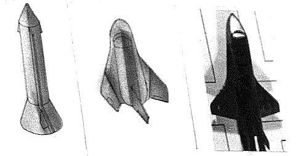 | Buran configurations Aerodynamic configurations of Buran tested during development. Credit: © Mark Wade |
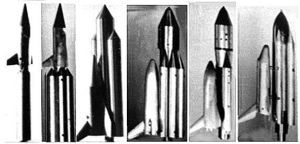 | Buran configurations Configurations of Buran launch vehicle tested during development. Credit: © Mark Wade |
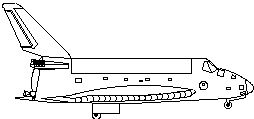 | Buran Credit: Manufacturer Image |
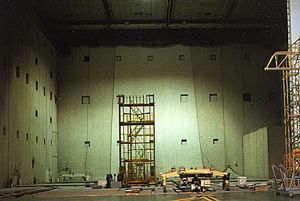 | Anechoic chamber The anechoic chamber where Buran was given antenna tests. It also shielded certain activities from US ELINT spacecraft. Credit: © Mark Wade |
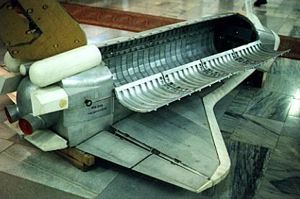 | Buran subscale model Buran subscale test article. Credit: © Mark Wade |
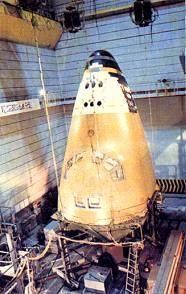 | Buran nose test Buran nose assembly in static test Credit: from Semenov, et. al., Buran, 1995. |
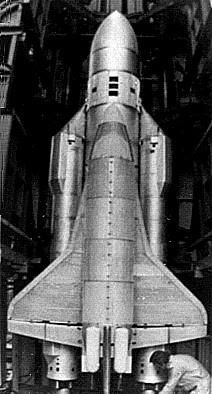 | Buran subscale model Buran subscale dynamic test article in test stand. Credit: © Mark Wade |
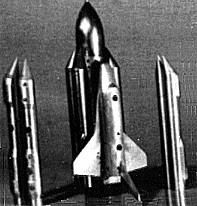 | Buran wind tunnel Buran wind tunnel model for testing strap on separation. Credit: © Mark Wade |
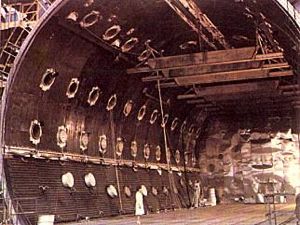 | TPVK-1 test chamber TPVK-1 Vacuum/insolation chamber used for full-scale tests on Buran Credit: from Semenov, et. al., Buran, 1995. |
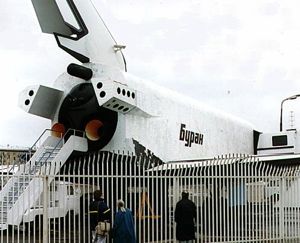 | Buran static article Converted Buran static article now a ride in Gorky Park Credit: © Mark Wade |
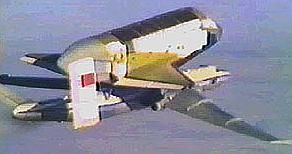 | Buran on 4MT Buran transported on 4MT aircraft |
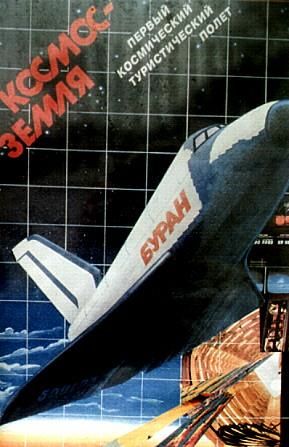 | Space - Earth! Space - Earth! First space tourism flight! Poster for Buran ride in Gorky Park. Credit: © Mark Wade |
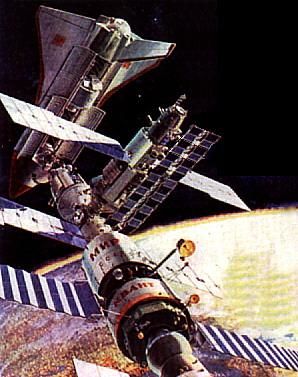 | Buran docks to Mir As it was supposed to be - Buran docking with Mir space station. |
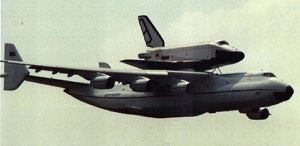 | Buran Atop Mriya Buran atop its An-225 Mriya carrier, as displayed at the Paris Air show shortly after its spaceflight. Credit: © Mark Wade |
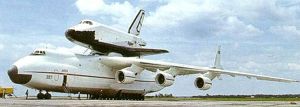 | An-225 / Buran |
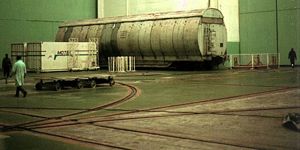 | Buran payload car Rail transport car for Buran payloads. Credit: © Mark Wade |
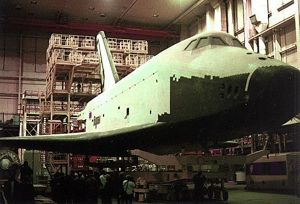 | Buran in storage Buran in storage at Baikonur. Credit: © Mark Wade |
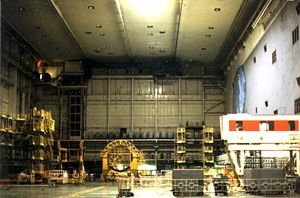 | Buran prep area Buran final preparation area before integration with Energia launch vehicle. Credit: © Mark Wade |
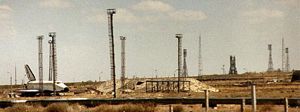 | Buran safing area Buran safing area with LC 1 launch pad in the distance. Credit: © Mark Wade |
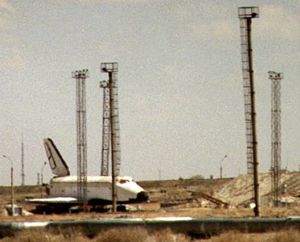 | Buran artilce Buran handling article deteriorates in safing area. Credit: © Mark Wade |
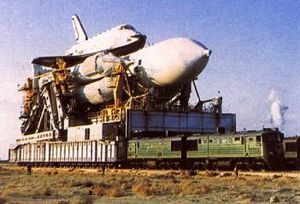 | Buran rollout - fwd Buran rollout - forward view of launch vehicle on transporter. Credit: from Semenov, et. al., Buran, 1995. |
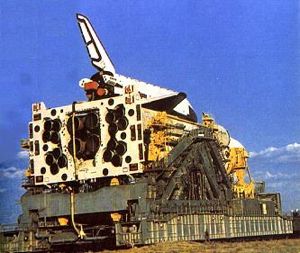 | Buran rollout - aft Buran rollout - aft view of launch vehicle on transporter. Credit: from Semenov, et. al., Buran, 1995. |
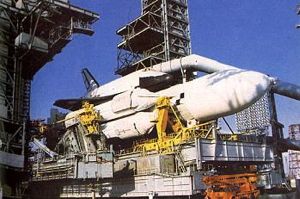 | Buran erected on pad Buran rollout - erection of launch vehicle on pad Credit: from Semenov, et. al., Buran, 1995. |
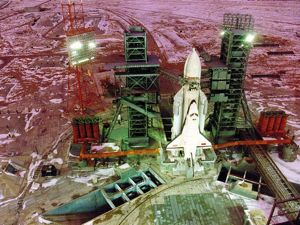 | Buran on pad Buran on pad - 800 pixel width Credit: Dr.Vadim P.Lukashevich |
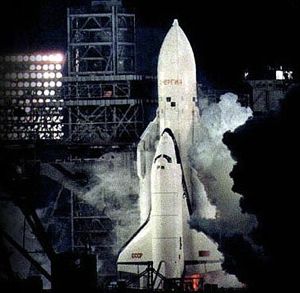 | Buran liftoff Credit: Dr.Vadim P.Lukashevich |
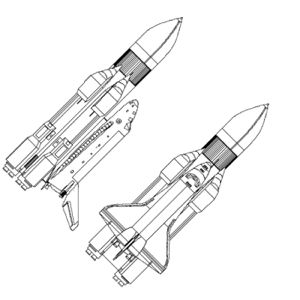 | Buran LV Credit: © Mark Wade |
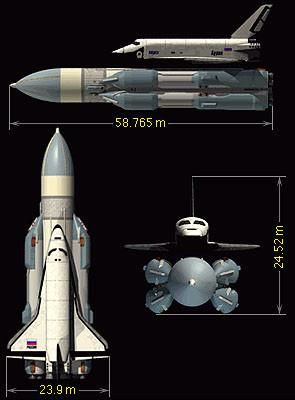 | Buran / Energia LV Buran / Energia launch vehicle - 3 view Credit: Dr.Vadim P.Lukashevich |
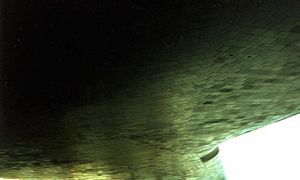 | Bottom of Buran Bottom of Buran, showing how thermal tiles were placed. Credit: © Mark Wade |
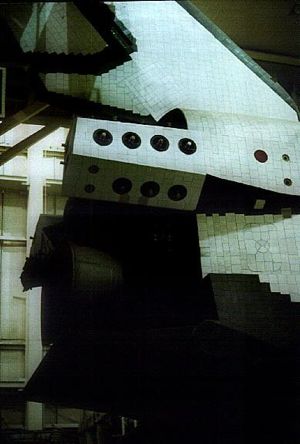 | Buran at Baikonur 3 View of tail section of Buran at the MIK in Baikonur. Credit: © Mark Wade |
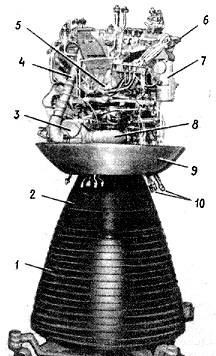 | Buran main engine Credit: from Semenov, et. al., Buran, 1995. |
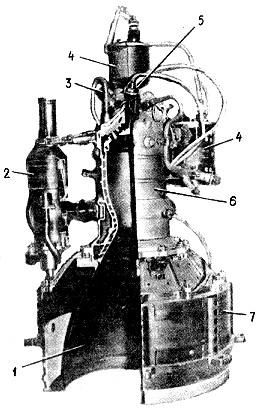 | Buran RCS Buran orientation engine Credit: from Semenov, et. al., Buran, 1995. |
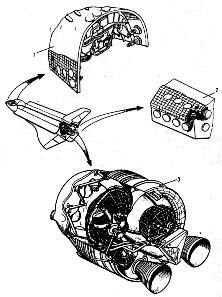 | Buran ODU Buran ODU engine system diagram Credit: from Semenov, et. al., Buran, 1995. |
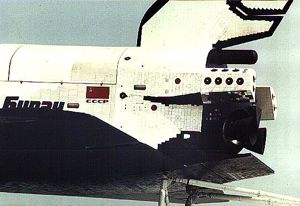 | Buran Back Side Close-up of Buran tail area, as displayed at the Paris Air show shortly after its spaceflight. Credit: © Mark Wade |
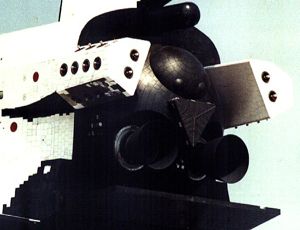 | Buran Engines Buran Detail of Engines Credit: © Mark Wade |
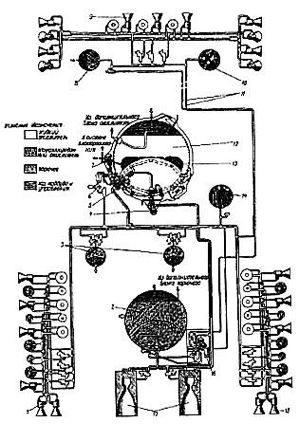 | Buran propulsion Buran propulsion system diagram Credit: from Semenov, et. al., Buran, 1995. |
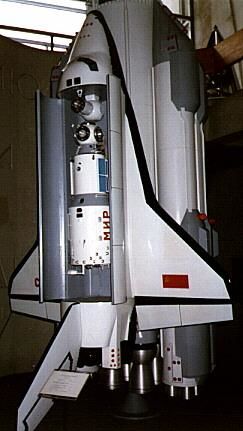 | Buran model with Mir Buran model with Mir station core as payload Credit: © Mark Wade |
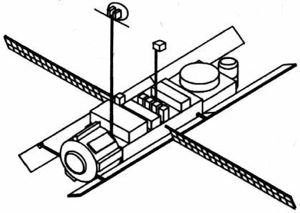 | Advanced Reconnsat Advanced Buran-serviced pallet-based reconnaissance platform designed by Kozlov OKB. |
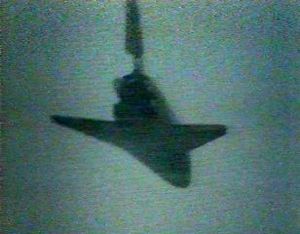 | Buran on approach Buran on landing glide slope as viewed from MiG-25 Credit: RKK Energia |
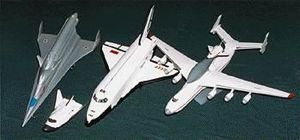 | Soviet Orbiters Soviet Spaceplanes: from left: Spiral, Uragan, Buran, MAKS |
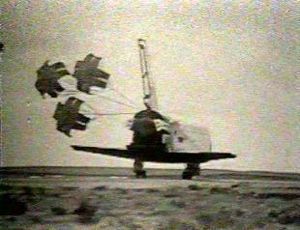 | Buran drag chute Buran drag chute deployment on landing. Credit: RKK Energia |
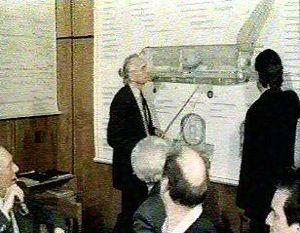 | Buran engineers Buran engineers discuss cutaway Credit: RKK Energia |
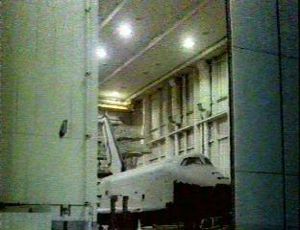 | Buran at Korolev Credit: RKK Energia |
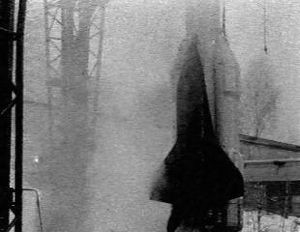 | Buran model test Test of Buran-Energia subscale model Credit: RKK Energia |
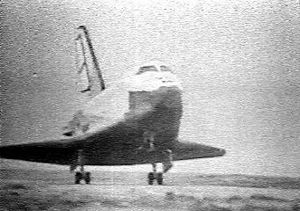 | Buran touchdown Credit: RKK Energia |
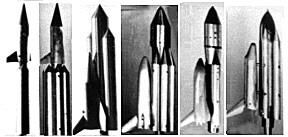 | Buran configurations Configurations of Buran launch vehicle tested during development. Credit: © Mark Wade |
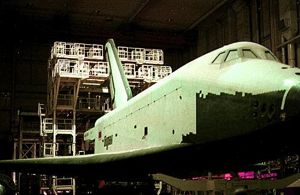 | Buran in storage Buran in storage at Baikonur. Credit: © Mark Wade |
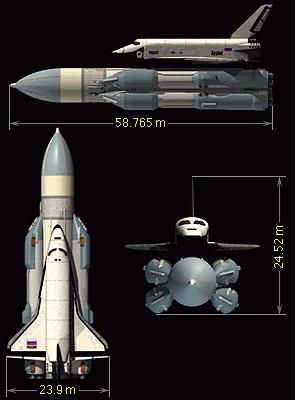 | Buran LV Buran-Energia launch vehicle 3 view |
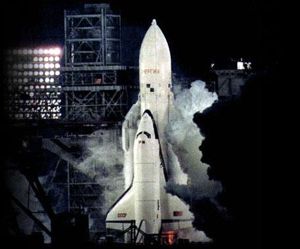 | Buran Liftoff Lift-off of Buran |
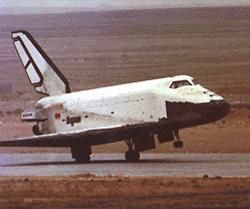 | Buran landing Credit: RKK Energia |
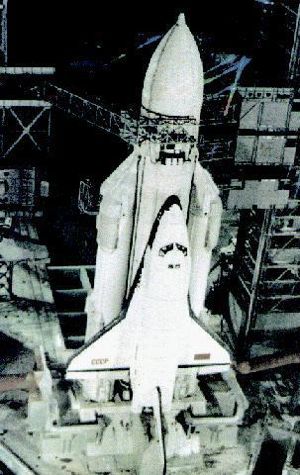 | Buran LV Buran LV on Launch Pad Credit: RKK Energia |
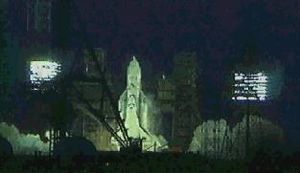 | Buran launch Credit: RKK Energia |
 | Buran Icon Credit: © Mark Wade |
 | Buran Credit: © Mark Wade |
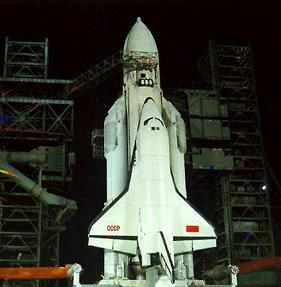 | Buran LV Credit: RKK Energia |
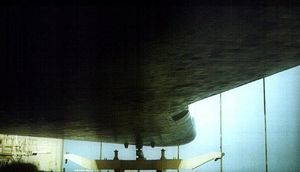 | Buran at Baikonur 2 View of underside of Buran spaceplane stored in the Energia MIK at Baikonur. Credit: © Mark Wade |
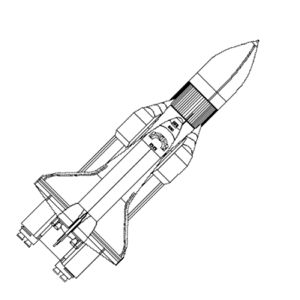 | Drawing of Buran LV Credit: © Mark Wade |
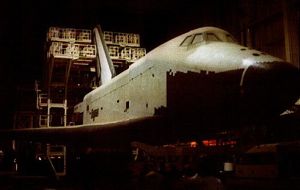 | Buran at Baikonur 1 Credit: © Mark Wade |
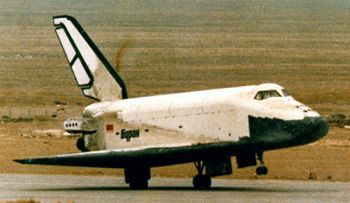 | Buran Credit: Manufacturer Image |
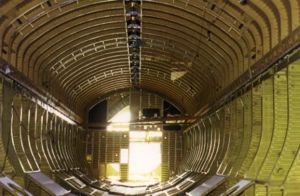 | Buran Structure Aft Interior structure of Buran at Gorkiy Park, looking aft Credit: © Dietrich Haeseler |
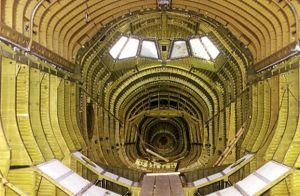 | Buran Structure Fwd Interior structure of Buran at Gorkiy Park, looking forward Credit: © Dietrich Haeseler |
1971 December 1 - . Launch Vehicle: Buran.
- Study of reusable space shuttle authorised. - . Nation: Russia. Spacecraft: Buran. Military-Industrial Commission (VPK) Decree 'On Carrying out Work on Reusable Space Systems-response to NASA's Space Shuttle' was issued..
1974 May 2 - .
- Development of Block R LH2/LOX stage begins - . Nation: Russia. Program: Buran. Development of the Block Sr for the N1M cancelled; work on the smaller Block R LH2/LOX stage was resumed. This stage was eventually to have been used on the Buran / Vulkan launch vehicles..
1974 August 1 - .
- New heavy-lift vehicle - .
Nation: Russia.
Related Persons: Brezhnev,
Glushko,
Keldysh,
Mishin,
Ustinov.
Spacecraft: Buran.
Glushko's first action was to implement a decision of the leadership to develop a completely new heavy-lift launch vehicle. This work started in 1974, with a planned first flight in 1984, at a total estimated cost of 5 to 6 billion roubles. One factor in the decision was the fact that Keldysh was greatly disturbed by the manoeuvrability of the space shuttle. He talked the matter up until he managed to get Ustinov and Brezhnev worked as well. He told them a US shuttle could manoeuvre around Soviet PVO and PKO anti-missile and satellite defences and deliver a 25 tonne nuclear bomb of greater than 25 megatons force directly on Moscow.
Keldysh was convinced that the US planned to use the shuttle for a pre-emptive nuclear strike on Russia. Therefore the USSR needed an analogous capability to maintain the strategic balance. While this discussion was going on, the energies of TsKBEM were completely absorbed in the Apollo-Soyuz program, on which the prestige of the Soviet Union depended. Additional Details: here....
1974 August 13 - .
- N1 work cancelled - .
Nation: Russia.
Related Persons: Glushko,
Keldysh,
Korolev,
Kuznetsov,
Mishin,
Ustinov.
Program: Lunar L3.
Spacecraft: Buran,
LK,
Soyuz 7K-LOK.
Glushko formally cancelled the N1 within the new NPO Energia on 13 August 1974 with the support of Ustinov, even though he had no decree of the VPK Military-Industrial Commission or the Central Committee authorising such an act. The N1-L3 itself was not officially closed down until the resolution of February 1976 starting work on the Energia/Buran boosters. By that time 6 billion roubles had been spent on the N1 over 17 years. Additional Details: here....
1976 February 12 - . Launch Vehicle: Buran.
- Development of Energia-Buran system authorised - .
Nation: Russia.
Spacecraft: Buran.
The government decree 132-51 authorising development of the Energia-Buran system was titled 'On development of an MKS (reusable space system) consisting of rocket stages, orbiter aircraft, inter-orbital tug, guidance systems, launch and landing facilities, assembly and repair facilities, and other associated facilities, with the objective of placing in a 200 km Northeast orbit a payload of 30 tonnes and returning a payload of 20 tonnes'. The Ministry of Defence was named the Program Manager, with NPO Energia as the prime contractor. The official military specification (TTZ) was issued at the same time with the code name Buran.
1976 February 17 - .
- Energia; Buran; Mir; Luch; Potok approved; N1 formally cancelled. - .
Nation: Russia.
Spacecraft: Buran,
Gamma,
Luch,
Mir,
Mir-2,
Potok.
Central Committee of the Communist Party and Council of Soviet Ministers Decree 'On work on Energia-Buran, DOS-7K nos. 7 and 8, Gamma. Geyzer (Potok), and Altair (Luch) and cancellation of the N1' was issued. The design of an improved model of the Salyut DOS-17K space station was authorised as part of the third generation of Soviet space systems in a decree. At that time it was planned that the two stations (DOS-7 and DOS-8) would be equipped with two docking ports at either end of the station and an additional two ports at the sides of the forward small diameter compartment. Luch and Potok were elements of the second generation global command and control system (GKKRS) deployed in the first half of the 1980's. Luch satellites, analogous to the US TDRS, provided communications service to the Mir space station, Buran space shuttle, Soyuz-TM spacecraft, military satellites, and the TsUPK ground control center. They also served to provide mobile fleet communications for the Soviet Navy. Additional Details: here....
1976 May 1 - .
- Plea for revival of N1 project - .
Nation: Russia.
Program: Lunar L3.
Spacecraft: Buran.
The workers on the project put together a letter to the 25th Party Congress, saying that N1 development should continue, and that N1 s/n's 8, 9, and 10 should be flown. The Party did not accept the letter. They had been assured by the leadership that the population of the city of Leninsk, the extensive facilities and housing built for the N1, would all be used for the MKTS Soviet shuttle. Iosifiyan considered the N1 fundamentally flawed, a project that was only approved due to Kremlin politics.
1976 June 11 - . Launch Vehicle: Buran.
- Buran design selected. - .
Nation: Russia.
Spacecraft: Buran.
Decree 'On selection of design layout for Buran' was issued. Following exhaustive analysis and inability to improve on the design, a straight aerodynamic copy of the US space shuttle, was selected as the Buran orbiter configuration. MiG was selected as subcontractor to build the orbiter. For this purpose MiG spun off a new design bureau, Molniya, with G E Lozino-Lozinskiy as chief designer.
1976 June 15 - . Launch Vehicle: Buran.
- Decree authorising development of 11B97 nuclear electric rocket stage - .
Nation: Russia.
Spacecraft Bus: TMK.
Spacecraft: Mars 1986.
Decree 'On course of work on nuclear rocket engines' was issued. The 11B97 stage would have an electric capacity of 500-600 kW and would use specialised plasma-ion electric engines using standing plasma waves and anodes. It was powered from a reactor with a 200 litre core containing 30 kg of uranium fuel. In 1978 this engine was studied for use as a reusable interorbital space tug for launch by Energia-Buran.
1976 October 12 - . Launch Vehicle: Buran.
- First ground test of Block R LH2/LOX upper stage - . Nation: Russia. Program: Buran. From 1976 to 1977 two Block R stages underwent thorough tests of all of their systems. The Block R could have operated up to 7 hours with 7 restarts. Not adopted for production for unknown reasons..
1976 November 8 - .
- Buran specification approved. - . Nation: Russia. Spacecraft: Buran. Decree 'On approval of a tactical-technical requirement for Buran' was issued..
1976 December 12 - . Launch Vehicle: Buran.
- Buran draft project completed. - . Nation: Russia. Program: Buran. Spacecraft: Buran. The MKS draft project was completed on 12 December 1976.The military assigned the system the index number 1K11K25 and the launch vehicle the article number 11K25..
1976 December 18 - . Launch Vehicle: Buran.
- Soviet Presidium directs co-operation on Buran - .
Nation: Russia.
Related Persons: Tsybin.
Spacecraft: Buran.
Military-Industrial Commission (VPK) Decree 'On course of work on Energia-Buran' was issued. The declaration of the Presidium directed co-operation between all concerned user, research, and factory organisations in realising the project. Chief Constructor within NPO Energia was I N Sadovskiy. Chief Designer for the launch vehicle was Y P Kolyako and for the orbiter P V Tsybin. NPO Yuzhnoye in the Ukraine would build the booster rockets.
1977 July - . Launch Vehicle: Buran.
1977 July 15 - . Launch Vehicle: Buran.
- Buran draft project reviewed by expert commission - . Nation: Russia. Program: Buran. Spacecraft: Buran. A critical step in any Soviet project, this approved the design and paved the way for development to begin..
1977 November 21 - . Launch Vehicle: Buran.
- Buran development plan approved - .
Nation: Russia.
Program: Buran.
Spacecraft: Buran.
The government decree 1006-323 set out the development plan. The flight test plan was for first launch of the booster in 1983, with the payload being an unmanned OK-ML-1 mock-up of the orbiter. This would not have a heat shield and remain attached to the booster. A second mock-up, OK-ML-2, would be used on the second launch, but be separated from the vehicle after burnout. However it would also be without heat shield, and be expended. The first flight Buran was to fly unpiloted in 1984. Manned flights were to be routine by the 1987 seventieth anniversary of the Soviet Union.
1977 December 1 - . Launch Vehicle: N1.
- Glushko uninterested in further lunar base work - .
Nation: Russia.
Related Persons: Bushuyev.
Spacecraft: Buran,
LEK,
Lunokhod LEK,
LZhM,
LZM.
Bushuyev tells Chertok that the lunar base work did not interest Glushko. The VPK Military-Industrial Commission was only interested in duplicating the American shuttle, not in any other ventures in space. With the N1-Sr booster, Russia could have had a six man lunar base established with 8 to 10 launches in the late 1970's. Bushuyev died on 26 October 1978, having seen his dream completely tossed away.
1978 - During the year - . Launch Vehicle: Buran.
- Work begins on conversion of 3M bomber to 3M-T Energia/Buran transport. - . Nation: Russia. Program: Buran. Spacecraft: Buran. 3M bomber was selected to carry piggy-back Energia core stage components and Buran orbiters..
1978 May - . Launch Vehicle: Buran.
- Buran technical project completed - .
Nation: Russia.
Spacecraft: Buran.
The technical project was completed in May 1978. The flight test plan at the beginning of the project foresaw first launch of the booster in 1983, with the payload being an unmanned OK-ML-1 mock-up of the orbiter. The first flight Buran was to fly unpiloted in 1984. Manned flights were to be routine by the 1987 seventieth anniversary of the Soviet Union.
1978 May 15 - . Launch Vehicle: Buran.
- Buran technical project completed. - . Nation: Russia. Program: Buran. Spacecraft: Buran. Buran engineering details were definitised and drawing release began to the production shops..
1979 During the Year - . Launch Vehicle: Buran.
- Buran model delivered to Baikonur - . Nation: Russia. Spacecraft: Buran. The EUK13 dimensional model of the launch vehicle was delivered to Baikonur for handling demonstrations and production of tooling..
1979 December 31 - . LV Family: Buran. Launch Vehicle: Energia.
- Energia model delivered to Baikonur - . Nation: Russia. Program: Buran. Spacecraft: Buran. In 1979 the EUK13 dimensional model of the Energia launch vehicle was delivered to Baikonur for handling demonstrations and production of tooling..
1981 February 5 - . Launch Vehicle: Buran.
- Decree for Gerkules nuclear-electric interorbital tug - .
Nation: Russia.
Spacecraft Bus: TMK.
Spacecraft: Mars 1986.
NPO Energia developed for the Ministry of Defence the interorbital tug Gerkules with 550 kW maximum output and continuous operation in the 50-150 kW range for 3 to 5 years. In 1986 an interorbital tug was studied to solve the specific application of transporting heavy satellites of 100 tonnes to geostationary orbit, launched by Energia.
1982 January - .
- Problems with development of Buran booster rockets - . Nation: Russia. Spacecraft: Buran. Continued development problems with the booster rockets led to a management shake-up at Yuzhnoye in January 1982. By this time the project was several years behind schedule. The originally planned first flight in 1983 was obviously unattainable..
1982 January 6 - . LV Family: Buran. Launch Vehicle: Energia.
- First test flight of VM-T transport with Energia hydrogen tank. - . Nation: Russia. Program: Buran. Spacecraft: Buran. First test of the modified 3M bomber, converted to carry piggy-back Energia core stage components and Buran orbiters..
1982 January 31 - . Launch Vehicle: Buran.
- Management shake-up at Yuzhnoye. - . Nation: Russia. Program: Buran. Spacecraft: Buran. Continued development problems with the Energia booster rockets led to a management shake-up at the Yuzhnoye design bureau..
1982 June 3 - . 21:30 GMT - . Launch Site: Kapustin Yar. Launch Complex: Kapustin Yar LC107/1. Launch Pad: LC107/pad?. LV Family: R-14. Launch Vehicle: K65M-RB.
- Cosmos 1374 - .
Mass: 1,000 kg (2,200 lb). Nation: Russia.
Agency: MO.
Program: Buran.
Class: Manned.
Type: Manned spaceplane. Spacecraft Bus: Spiral 50-50.
Spacecraft: BOR-4.
Duration: 0.0700 days. Decay Date: 1982-06-03 . USAF Sat Cat: 13257 . COSPAR: 1982-054A. Apogee: 204 km (126 mi). Perigee: 158 km (98 mi). Inclination: 50.70 deg. Period: 88.10 min.
Subscale Spiral spaceplane. After 1.25 revolutions of the earth, deorbited and recovered by Soviet naval forces in the Indian Ocean at 17 degrees South, 98 degrees East, 560 km south of Cocos Islands. Made a 600 km cross-range maneuver during reentry. The recovery was filmed by an Australian Orion reconnaissance aircraft, revealing the configuration to the West for the first time.
1982 December - . Launch Vehicle: Buran.
- 4M Energia mock-up completed, - . Nation: Russia. Spacecraft: Buran. During 1982 the 3M-T transport aircraft was completed and began delivery of central block propellant tanks and structural elements for construction of a realistic mock-up of the booster..
1982 December 31 - . Launch Vehicle: Buran.
- 3M-T Buran transport aircraft delivered - .
Nation: Russia.
Program: Buran.
Spacecraft: Buran.
The 3M-T transport aircraft was completed and began delivery of central block propellant tanks and structural elements for construction of a realistic mock-up of the Energia booster. The 3M-T was a heavily modified M-4 bomber, and was limited to 50 tonnes loads carried on the top of the fuselage.
1982 December 31 - . LV Family: Buran. Launch Vehicle: Energia.
- Energia mock-up completed - . Nation: Russia. Program: Buran. Spacecraft: Buran. The 4M Energia launch vehicle high fidelity mock-up was completed at Baikonur..
1983 March 1 - .
1983 March 15 - . 22:30 GMT - . Launch Site: Kapustin Yar. Launch Complex: Kapustin Yar LC107/1. Launch Pad: LC107/pad?. LV Family: R-14. Launch Vehicle: K65M-RB.
- Cosmos 1445 - . Mass: 1,000 kg (2,200 lb). Nation: Russia. Agency: MO. Program: Buran. Class: Manned. Type: Manned spaceplane. Spacecraft Bus: Spiral 50-50. Spacecraft: BOR-4. Duration: 0.0700 days. Decay Date: 1983-03-16 . USAF Sat Cat: 13883 . COSPAR: 1983-017A. Apogee: 208 km (129 mi). Perigee: 158 km (98 mi). Inclination: 50.70 deg. Period: 88.20 min. Subscale Spiral spaceplane. After 1.25 revolutions of the earth, deorbited and recovered by Soviet naval forces in the Indian Ocean, 556 km south of the Cocos Islands ..
1983 May - . LV Family: Buran. Launch Vehicle: Energia.
- Energia dynamic tests - . Nation: Russia. Spacecraft: Buran. The 4M Energia mock-up was subjected to dynamic / vertical / load tests in May-October 1983. The 4M was then returned to the shop for fitting of complete functional propellant systems..
1983 May 15 - . LV Family: Buran. Launch Vehicle: Energia.
- Energia full-scale loads tests - . Nation: Russia. Program: Buran. Spacecraft: Buran. The 4M Energia mock-up was used for dynamic/vertical/load tests in May-October 1983. The 4M was then returned to the shop for fitting of complete functional propellant systems..
1983 August - . LV Family: Buran. Launch Vehicle: Energia.
- OK-KS Buran systems test stand completed - .
Nation: Russia.
Spacecraft: Buran.
The OK-KS Buran systems test stand was built at NPO Energia to conduct tests not possible on other stands. These included electrical layout, pneumo-hydraulic tests in abort conditions, EMI tests, failure mode response, telemetry, interface with the launch vehicle, software systems test.
1983 August 15 - .
- OK-KS Buran systems test stand completed - .
Nation: Russia.
Program: Buran.
Spacecraft: Buran.
The OK-KS Buran systems test stand was built at NPO Energia to conduct tests not possible on other stands. These included electrical layout, pneumo-hydraulic tests in abort conditions, EMI tests, failure mode response, telemetry, interface with the launch vehicle, software systems test. The test series was completed in March 1984. 77% of the tests of the OK were automated, compared with only 5% for the Soyuz-TM.
1983 December - . LV Family: Buran. Launch Vehicle: Energia.
- Buran OK-ML-1 mock-up arrived at Baikonur - .
Nation: Russia.
Spacecraft: Buran.
The OK-ML-1 orbiter mock-up arrived atop the 3M-T at Baikonur. This action seems to have been in the fine Soviet tradition of individual enterprises proving they have met the plan, even if the method of doing it is useless. OK-ML-1 was to have been used in the first launch of the Energia, by the end of 1983. By delivering it to Baikonur by December 31, the spacecraft builders could claim, 'well, we met OUR part of the plan...'). OK-ML-1 was used for handling and pad compatibility tests.
1983 December 13 - .
- Flight trials of Buran auto-land system aboard Tu-154 test-bed. - . Nation: Russia. Program: Buran. Spacecraft: Buran. Flight trials of the Buran automatic landing system are begun on a modified Tu-154 transport..
1983 December 27 - . 10:00 GMT - . Launch Site: Kapustin Yar. Launch Complex: Kapustin Yar LC107/1. Launch Pad: LC107/pad?. LV Family: R-14. Launch Vehicle: K65M-RB.
- Cosmos 1517 - . Mass: 1,000 kg (2,200 lb). Nation: Russia. Agency: MO. Program: Buran. Class: Manned. Type: Manned spaceplane. Spacecraft Bus: Spiral 50-50. Spacecraft: BOR-4. Duration: 0.0500 days. Decay Date: 1983-12-27 . USAF Sat Cat: 14585 . COSPAR: 1983-125A. Apogee: 217 km (134 mi). Perigee: 212 km (131 mi). Inclination: 50.70 deg. Period: 88.80 min. Subscale Spiral spaceplane. In a new mission profile, braked out of orbit over the South Atlantic and was recovered in the Black Sea after one orbit of the Earth..
1983 December 31 - . LV Family: Buran. Launch Vehicle: Energia.
- OK-ML-1 orbiter mock-up arrives at Baikonur - .
Nation: Russia.
Program: Buran.
Spacecraft: Buran.
The OK-ML-1 mock-up arrived atop the 3M-T transport aircraft. OK-ML-1 was originally to have been used in the first launch of the Energia, by the end of 1983. But the program was years behind schedule, and in the end the OK-ML-1 was used for handling and pad compatibility tests.
1984 March - .
- OK-KS Buran systems test series completed - . Nation: Russia. Spacecraft: Buran. 77% of the tests of the OK were automated, compared with only 5% for the Soyuz-TM..
1984 July 5 - . Launch Site: Kapustin Yar. Launch Complex: Kapustin Yar LC107/1. Launch Pad: LC107/pad?. LV Family: R-14. Launch Vehicle: K65M-RB.
- BOR-5 sn 501 subscale 1:8 Buran reentry test - . Mass: 1,450 kg (3,190 lb). Nation: Russia. Agency: UNKS. Program: Buran. Spacecraft Bus: Buran. Spacecraft: BOR-5. Apogee: 210 km (130 mi). Range: 2,000 km (1,200 mi). Suborbital test of 1/8 scale model of Buran. Typical trajectory: ascent to 210 km; pitch down to drive model in atmosphere at 45 degree at Mach 18.5. None were reflown but at least 4 were recovered..
1984 August - .
- Buran OK-MT mock-up arrived at Baikonur - . Nation: Russia. Spacecraft: Buran. This functional mock-up was used for systems integration tests, and was to be expended on the second test flight..
1984 August 31 - . LV Family: Buran. Launch Vehicle: Energia.
- OK-ML-2 orbiter mock-up arrives at Baikonur - . Nation: Russia. Program: Buran. Spacecraft: Buran. The OK-ML-2 (former OK-MT) functional mock-up was used for systems integration tests, and was to have been expended on the second test flight..
1984 December 19 - . 03:55 GMT - . Launch Site: Kapustin Yar. Launch Complex: Kapustin Yar LC107/1. Launch Pad: LC107/pad?. LV Family: R-14. Launch Vehicle: K65M-RB.
- Cosmos 1614 - . Mass: 1,000 kg (2,200 lb). Nation: Russia. Agency: MO. Program: Buran. Class: Manned. Type: Manned spaceplane. Spacecraft Bus: Spiral 50-50. Spacecraft: BOR-4. Duration: 0.0500 days. Decay Date: 1984-12-19 . USAF Sat Cat: 15442 . COSPAR: 1984-126A. Apogee: 223 km (138 mi). Perigee: 174 km (108 mi). Inclination: 50.70 deg. Period: 88.50 min. Last flight of the subscale Spiral spaceplane. Recovered December 19, 1984 5:26 GMT, in the Black Sea after one orbit of the Earth..
1984 December 29 - . Launch Site: Baikonur. Launch Complex: Baikonur Jubilee.
- Buran Analog BST-02 taxi test 1 - . Crew: Stankevicius, Volk. Nation: Russia. Related Persons: Stankevicius, Volk. Program: Buran. Class: Manned. Type: Manned spaceplane. Spacecraft Bus: Buran. Spacecraft: Buran Analogue. Maximum speed 45 kph. Time 5 minutes. Thereafter to PRSO test stand for full-scale equipment tests; then to PDST pilot-dynamics test stand for further tests..
1985 - During the year - . Launch Vehicle: MAKS.
- An-225 project started. - . Nation: Russia. Program: Buran. Spacecraft: Buran. System specification issued for An-225 heavy transport, which will replace 3M-T for transport of Energia core stage components and the Buran spaceplane. The aircraft will also be the launcher for the MAKS spaceplane..
1985 March - . LV Family: Buran. Launch Vehicle: Energia.
- Energia cold flow tests begun - . Nation: Russia. Spacecraft: Buran. From March-October 1985 the Ts core stage was back on the UKSS for cold flow tests. A total of nine cryogenic fuelling cycle were completed with the 4M Energia mock-up, representing the first operational use in the world of super-chilled hydrogen..
1985 March 15 - . LV Family: Buran. Launch Vehicle: Energia.
- Energia cold flow tests. - .
Nation: Russia.
Program: Buran.
Spacecraft: Buran.
From March-October 1985 the Ts core stage was back on the UKSS test/launch stand for cold flow tests. A total of nine cryogenic fuelling cycle were completed with the 4M Energia mock-up, representing the first operational use in the world of super-chilled hydrogen.
1985 April 17 - . Launch Site: Kapustin Yar. Launch Complex: Kapustin Yar LC107/1. Launch Pad: LC107/pad?. LV Family: R-14. Launch Vehicle: K65M-RB.
- BOR-5 sn 502 subscale 1:8 Buran reentry test - . Mass: 1,450 kg (3,190 lb). Nation: Russia. Agency: UNKS. Program: Buran. Spacecraft Bus: Buran. Spacecraft: BOR-5. Apogee: 210 km (130 mi). Range: 2,000 km (1,200 mi). Suborbital test of 1/8 scale model of Buran. Typical trajectory: ascent to 210 km; pitch down to drive model in atmosphere at 45 degree at Mach 18.5. None were reflown but at least 4 were recovered..
1985 August 2 - . Launch Site: Baikonur. Launch Complex: Baikonur Jubilee.
- Buran Analog BST-02 taxi test 2 - . Crew: Stankevicius, Volk. Nation: Russia. Related Persons: Stankevicius, Volk. Program: Buran. Class: Manned. Type: Manned spaceplane. Spacecraft Bus: Buran. Spacecraft: Buran Analogue. Maximum speed 200 kph. Time 14 minutes..
1985 October 5 - . Launch Site: Baikonur. Launch Complex: Baikonur Jubilee.
- Buran Analog BST-02 taxi test 3 - . Crew: Stankevicius, Volk. Nation: Russia. Related Persons: Stankevicius, Volk. Program: Buran. Class: Manned. Type: Manned spaceplane. Spacecraft Bus: Buran. Spacecraft: Buran Analogue. Maximum speed 270 kph. Time 12 minutes..
1985 October 15 - . Launch Site: Baikonur. Launch Complex: Baikonur Jubilee.
- Buran Analog BST-02 taxi test 4 - . Crew: Stankevicius, Volk. Nation: Russia. Related Persons: Stankevicius, Volk. Program: Buran. Class: Manned. Type: Manned spaceplane. Spacecraft Bus: Buran. Spacecraft: Buran Analogue. Maximum speed 300 kph..
1985 November 10 - . Launch Site: Baikonur. Launch Complex: Baikonur Jubilee.
- Buran Analog BST-02 flight 1 - . Crew: Stankevicius, Volk. Nation: Russia. Related Persons: Stankevicius, Volk. Program: Buran. Class: Manned. Type: Manned spaceplane. Spacecraft Bus: Buran. Spacecraft: Buran Analogue. Maximum speed 480 kph. Maximum altitude 1500 m. Time 12 minutes..
1985 November 10 - .
- First OK-GLI Buran analogue flight - .
Nation: Russia.
Spacecraft: Buran.
Cosmonaut Igor Volk was at the controls; takeoff was from the Zhukovskiy test flight centre near Moscow. Two flying labs, based on Tu-154 transports, were used to prior to this to duplicate anticipated Buran handling and test systems software. They conducted 140 flights before Buran's first flight, including 69 automatic landings at Zhukovskiy and at the Jubilee airfield at Baikonur.
1985 November 15 - . Launch Site: Baikonur. Launch Complex: Baikonur Jubilee.
- Buran Analog BST-02 taxi test 5 - . Crew: Stankevicius, Volk. Nation: Russia. Related Persons: Stankevicius, Volk. Program: Buran. Class: Manned. Type: Manned spaceplane. Spacecraft Bus: Buran. Spacecraft: Buran Analogue. Maximum speed 170 kph. Time 12 minutes..
1985 December - . LV Family: Buran. Launch Vehicle: Energia.
- Buran wings delivered to Baikonur - .
Nation: Russia.
Spacecraft: Buran.
In December 1985 the wings of the first flight OK arrived at Baikonur. This was followed by what was to be the first 20 second Energia main engine firing test. This was terminated at 2.58 seconds when the automatic control system detected a slow spool up of an engine turbine. In a the first attempt at a full-duration test helium leaks contaminated electro-hydraulic systems, leading to a situation where the tanks could not be drained. An engineering brigade had to work on the fuelled booster for 55 minutes, attach another helium tank, which led to successful de-fuelling of the vehicle. The second engine test was a complete success, the engine running for 390 seconds. This test required the entire city of Leninsk to be without water for ten days in order to accumulate enough water for the UKSS cooling system.
1985 December 15 - .
- Wings for first flight Buran arrive at Baikonur - . Nation: Russia. Program: Buran. Spacecraft: Buran.
1986 January - . Launch Vehicle: Buran.
- Buran program shakeup - .
Nation: Russia.
Spacecraft: Buran.
By January 1986 it was clear that the project, now three years behind schedule, had no prospect of completion due to problems in obtaining deliveries of equipment for Buran, numerous problems in assembling the orbiters and lack of manpower at Baikonur, and a general loss of management focus. Minister O D Bakhnov called large group of industry leaders to the cosmodrome to review measures to concentrate and accelerate the remaining work. Three 'Tiger Teams' were set up. The first, led by Semenov, was to finish the flight Buran orbiter and associated facilities in time for a third quarter 1987 launch. The second, led by B I Gubanov, was to finish the Energia launch vehicle and fly it, without the Buran mock-ups if necessary, at the earliest possible date. The third group, led by S S Banin, was to complete the assembly and launch facilities.
1986 January 3 - . Launch Site: Baikonur. Launch Complex: Baikonur Jubilee.
- Buran Analog BST-02 flight 2 - . Crew: Stankevicius, Volk. Nation: Russia. Related Persons: Stankevicius, Volk. Program: Buran. Class: Manned. Type: Manned spaceplane. Spacecraft Bus: Buran. Spacecraft: Buran Analogue. Maximum speed 520 kph. Maximum altitude 3000 m. Time 36 minutes..
1986 January 31 - . Launch Vehicle: Buran.
- Buran project in crisis - .
Nation: Russia.
Program: Buran.
Spacecraft: Buran.
By January 1986 it was clear that the project, now three years behind schedule, had no prospect of completion due to problems in obtaining deliveries of equipment for Buran, numerous problems in assembling the orbiters and lack of manpower at Baikonur, and a general loss of management focus. Minister O D Bakhnov called a large group of industry leaders to the cosmodrome to review measures to concentrate and accelerate the remaining work. Three 'Tiger Teams' were set up. The first, led by Semenov, was to finish the flight Buran orbiter and associated facilities in time for a third quarter 1987 launch. The second, led by B I Gubanov, was to finish the Energia launch vehicle and fly it, without the Buran mock-ups if necessary, at the earliest possible date. The third group, led by S S Banin, was to complete the assembly and launch facilities.
1986 February - . Launch Vehicle: Buran.
- Frst Buran payload arrived in Baikonur - .
Nation: Russia.
Spacecraft: Buran.
The first Buran payload, 37KB module s/n 37070, arrived in Baikonur. The 37KB modules, similar to the Kvant module of the Mir space station, were to be standard on the early Buran flights. 37KB-37070 itself primarily contained instrumentation to measure the performance of the orbiter and its structure on its first flight.
1986 February 15 - .
- First Buran payload arrives at Baikonur - .
Nation: Russia.
Program: Buran.
Spacecraft: Buran.
The first Buran payload, 37KB module s/n 37070, is delivered by freight car. The 37KB modules, similar to the Kvant module of the Mir space station, were to be standard on the early Buran flights. 37KB-37070 itself primarily contained instrumentation to measure the performance of the orbiter and its structure on its first flight.
1986 March 21 - . LV Family: Buran. Launch Vehicle: Energia.
- First Energia full thrust test - .
Nation: Russia.
Program: Buran.
Spacecraft: Buran.
This was to be the first 20 second Energia main engine firing test. It was terminated at 2.58 seconds when the automatic control system detected a slow spool up of an engine turbine. In a the first attempt at a full-duration test helium leaks contaminated electro-hydraulic systems, leading to a situation where the tanks could not be drained. An engineering brigade had to work on the fuelled booster for 55 minutes, attach another helium tank, which led to successful de-fuelling of the vehicle.
1986 April 26 - . Launch Site: Baikonur. Launch Complex: Baikonur Jubilee.
- Buran Analog BST-02 taxi test 6 - . Crew: Levchenko, Shchukin. Nation: Russia. Related Persons: Levchenko, Shchukin. Program: Buran. Class: Manned. Type: Manned spaceplane. Spacecraft Bus: Buran. Spacecraft: Buran Analogue. Time 14 minutes..
1986 May - . Launch Vehicle: Buran.
- Electrical tests of the Buran flight vehicle began - .
Nation: Russia.
Spacecraft: Buran.
Tests of the orbiter's ODU engine unit uncovered an apparent defect in gaseous oxygen valves of the reaction control system. Although it threatened to delay flight of the Buran, it was eventually discovered to be a software problem and remedied within days.
1986 May 15 - .
- Electrical tests of the Buran flight vehicle begin - . Nation: Russia. Program: Buran. Spacecraft: Buran.
1986 May 27 - . Launch Site: Baikonur. Launch Complex: Baikonur Jubilee.
- Buran Analog BST-02 flight 3 - . Crew: Stankevicius, Volk. Nation: Russia. Related Persons: Stankevicius, Volk. Program: Buran. Class: Manned. Type: Manned spaceplane. Spacecraft Bus: Buran. Spacecraft: Buran Analogue. Maximum speed 540 kph. Maximum altitude 4000 m. Time 23 minutes..
1986 June 11 - . Launch Site: Baikonur. Launch Complex: Baikonur Jubilee.
- Buran Analog BST-02 flight 4 - . Crew: Stankevicius, Volk. Nation: Russia. Related Persons: Stankevicius, Volk. Program: Buran. Class: Manned. Type: Manned spaceplane. Spacecraft Bus: Buran. Spacecraft: Buran Analogue. Maximum speed 530 kph. Maximum altitude 4000 m. Time 22 minutes..
1986 June 20 - . Launch Site: Baikonur. Launch Complex: Baikonur Jubilee.
- Buran Analog BST-02 flight 5 - . Crew: Levchenko, Shchukin. Nation: Russia. Related Persons: Levchenko, Shchukin. Program: Buran. Class: Manned. Type: Manned spaceplane. Spacecraft Bus: Buran. Spacecraft: Buran Analogue. Time 25 minutes..
1986 June 28 - . Launch Site: Baikonur. Launch Complex: Baikonur Jubilee.
- Buran Analog BST-02 flight 6 - . Crew: Levchenko, Shchukin. Nation: Russia. Related Persons: Levchenko, Shchukin. Program: Buran. Class: Manned. Type: Manned spaceplane. Spacecraft Bus: Buran. Spacecraft: Buran Analogue. Time 23 minutes..
1986 July - . LV Family: Buran. Launch Vehicle: Energia.
- Polyus mock-up delivered to Baikonur - . Nation: Russia. Spacecraft Bus: TKS. Spacecraft: Polyus. A Polyus mock-up was delivered by the Krunichev Factory to Baikonur Cosmodrome, for tests of the Polyus/Energia interface. The spacecraft was about 37 meters in length, 4.1 meters in diameter and weighed about 80 metric tons..
1986 August - . LV Family: Buran. Launch Vehicle: Energia.
- UKSS static tests of Energia - .
Nation: Russia.
Related Persons: Glushko.
Spacecraft: Buran.
Further UKSS tests of Energia were conducted in preparation of a test launch without Buran. These were conducted using a dummy payload and solid rocket motors to simulate loads from the booster rockets. Following this vehicle 6SL was selected for the first actual launch. The launch vehicle used by itself without Buran was named Energia by Glushko only just before the launch.
1986 August 15 - . LV Family: Buran. Launch Vehicle: Energia.
- Tests of Energia with payload cannister - . Nation: Russia. Program: Buran. Spacecraft: Buran. Following the decision to make the first flight of Energia without a Buran orbiter, in August-September 1986 further UKSS tests of Energia were conducted. These used a dummy payload and solid rocket motors to simulate loads from the booster rockets..
1986 September 1 - . LV Family: Buran. Launch Vehicle: Energia.
- Second Energia full thrust test - . Nation: Russia. Program: Buran. Spacecraft: Buran. The second engine test was a complete success, the engine running for 390 seconds. This test required the entire city of Leninsk to be without water for ten days in order to accumulate enough water for the UKSS cooling system..
1986 December 10 - . Launch Site: Baikonur. Launch Complex: Baikonur Jubilee.
- Buran Analog BST-02 flight 7 - . Crew: Stankevicius, Volk. Nation: Russia. Related Persons: Stankevicius, Volk. Program: Buran. Class: Manned. Type: Manned spaceplane. Spacecraft Bus: Buran. Spacecraft: Buran Analogue. First automatic landing from 4000 m altitude. Time 24 minutes..
1986 December 23 - . Launch Site: Baikonur. Launch Complex: Baikonur Jubilee.
- Buran Analog BST-02 flight 8 - . Crew: Stankevicius, Volk. Nation: Russia. Related Persons: Stankevicius, Volk. Program: Buran. Class: Manned. Type: Manned spaceplane. Spacecraft Bus: Buran. Spacecraft: Buran Analogue. Time 17 minutes..
1986 December 26 - . Launch Site: Kapustin Yar. Launch Complex: Kapustin Yar LC107/1. Launch Pad: LC107/pad?. LV Family: R-14. Launch Vehicle: K65M-RB.
- BOR-5 sn 503 subscale 1:8 Buran reentry test - . Mass: 1,450 kg (3,190 lb). Nation: Russia. Agency: UNKS. Program: Buran. Spacecraft Bus: Buran. Spacecraft: BOR-5. Apogee: 210 km (130 mi). Range: 2,000 km (1,200 mi). Suborbital test of 1/8 scale model of Buran. Typical trajectory: ascent to 210 km; pitch down to drive model in atmosphere at 45 degree at Mach 18.5. None were reflown but at least 4 were recovered..
1986 December 29 - . Launch Site: Baikonur. Launch Complex: Baikonur Jubilee.
- Buran Analog BST-02 flight 9 - . Crew: Levchenko, Shchukin. Nation: Russia. Related Persons: Levchenko, Shchukin. Program: Buran. Class: Manned. Type: Manned spaceplane. Spacecraft Bus: Buran. Spacecraft: Buran Analogue. Time 17 minutes..
1987 February 16 - . Launch Site: Baikonur. Launch Complex: Baikonur Jubilee.
- Buran Analog BST-02 flight 10 - . Crew: Stankevicius, Volk. Nation: Russia. Related Persons: Stankevicius, Volk. Program: Buran. Class: Manned. Type: Manned spaceplane. Spacecraft Bus: Buran. Spacecraft: Buran Analogue. Time 28 minutes..
1987 February 25 - . Launch Site: Baikonur. Launch Complex: Baikonur Jubilee.
- Buran Analog BST-02 flight 11 - . Crew: Stankevicius, Volk. Nation: Russia. Related Persons: Stankevicius, Volk. Program: Buran. Class: Manned. Type: Manned spaceplane. Spacecraft Bus: Buran. Spacecraft: Buran Analogue. Time 19 minutes..
1987 March 29 - . Launch Site: Baikonur. Launch Complex: Baikonur Jubilee.
- Buran Analog BST-02 taxi test 7 - . Crew: Levchenko, Shchukin. Nation: Russia. Related Persons: Levchenko, Shchukin. Program: Buran. Class: Manned. Type: Manned spaceplane. Spacecraft Bus: Buran. Spacecraft: Buran Analogue. Time 2 minutes..
1987 March 30 - . Launch Site: Baikonur. Launch Complex: Baikonur Jubilee.
- Buran Analog BST-02 taxi test 8 - . Crew: Levchenko, Shchukin. Nation: Russia. Related Persons: Levchenko, Shchukin. Program: Buran. Class: Manned. Type: Manned spaceplane. Spacecraft Bus: Buran. Spacecraft: Buran Analogue. Time 25 minutes..
1987 May 11 - . LV Family: Buran. Launch Vehicle: Energia.
- Energia-Polyus - .
Nation: Russia.
Spacecraft: Buran.
Energia was to deliver the military Skif-DM Polyus battle station into orbit. Due to delays in completion of the enormous static test facility at Baikonur, which could test the entire Energia vehicle stack, it was decided to launch the vehicle without the verification the tests would provide. The launch of 6SL was planned for 21:30 Moscow time. It was delayed five hours when a leak was detected in the Block 3A electrical distribution section, then by another hour due to a fault LH2 thermostat. The launch vehicle performed successfully, but the payload failed to inject itself into orbit due to a guidance system failure.
1987 May 15 - . 17:30 GMT - . Launch Site: Baikonur. Launch Complex: Baikonur LC250. LV Family: Buran. Launch Vehicle: Energia. FAILURE: No orbital insertion due to failure of the FGB attitude control system (Energia performed perfectly). Partial Failure.. Failed Stage: P.
- Polyus - .
Payload: Skif-DM. Mass: 80,000 kg (176,000 lb). Nation: Russia.
Agency: UNKS.
Program: Buran.
Class: Military.
Type: Strategic defense satellite. Spacecraft Bus: TKS.
Spacecraft: Polyus.
Decay Date: 1987-05-15 . COSPAR: F870515A.
Due to delays in completion of the enormous static test facility at Baikonur, which could test the entire Energia vehicle stack, it was decided to launch the vehicle without the verification the tests would provide. The launch of 6SL was planned for 11 May 1987 at 21:30 Moscow time. It was delayed five days when a leak was detected in the Block 3A electrical distribution section, then by another hour due to a fault LH2 thermostat. The launch vehicle performed successfully, but the Polyus payload failed to inject itself into orbit due to a guidance system failure. Additional Details: here....
1987 May 21 - . Launch Site: Baikonur. Launch Complex: Baikonur Jubilee.
- Buran Analog BST-02 flight 12 - . Crew: Levchenko, Shchukin. Nation: Russia. Related Persons: Levchenko, Shchukin. Program: Buran. Class: Manned. Type: Manned spaceplane. Spacecraft Bus: Buran. Spacecraft: Buran Analogue. Time 20 minutes..
1987 June 25 - . Launch Site: Baikonur. Launch Complex: Baikonur Jubilee.
- Buran Analog BST-02 flight 13 - . Crew: Stankevicius, Volk. Nation: Russia. Related Persons: Stankevicius, Volk. Program: Buran. Class: Manned. Type: Manned spaceplane. Spacecraft Bus: Buran. Spacecraft: Buran Analogue. Time 19 minutes..
1987 August 27 - . Launch Site: Kapustin Yar. Launch Complex: Kapustin Yar LC107/1. Launch Pad: LC107/pad?. LV Family: R-14. Launch Vehicle: K65M-RB.
- BOR-5 sn 504 subscale 1:8 Buran reentry test - . Mass: 1,450 kg (3,190 lb). Nation: Russia. Agency: UNKS. Program: Buran. Spacecraft Bus: Buran. Spacecraft: BOR-5. Apogee: 210 km (130 mi). Range: 2,000 km (1,200 mi). Suborbital test of 1/8 scale model of Buran. Typical trajectory: ascent to 210 km; pitch down to drive model in atmosphere at 45 degree at Mach 18.5. None were reflown but at least 4 were recovered..
1987 October 5 - . Launch Site: Baikonur. Launch Complex: Baikonur Jubilee.
- Buran Analog BST-02 flight 14 - . Crew: Shchukin, Volk. Nation: Russia. Related Persons: Shchukin, Volk. Program: Buran. Class: Manned. Type: Manned spaceplane. Spacecraft Bus: Buran. Spacecraft: Buran Analogue. Automatic landing. Time 21 minutes..
1987 October 15 - . Launch Site: Baikonur. Launch Complex: Baikonur Jubilee.
- Buran Analog BST-02 flight 15 - . Crew: Bachurin, Borodai. Nation: Russia. Related Persons: Bachurin, Borodai. Program: Buran. Class: Manned. Type: Manned spaceplane. Spacecraft Bus: Buran. Spacecraft: Buran Analogue. Time 19 minutes..
1988 January 16 - . Launch Site: Baikonur. Launch Complex: Baikonur Jubilee.
- Buran Analog BST-02 flight 16 - . Crew: Stankevicius, Volk. Nation: Russia. Related Persons: Stankevicius, Volk. Program: Buran. Class: Manned. Type: Manned spaceplane. Spacecraft Bus: Buran. Spacecraft: Buran Analogue.
1988 January 24 - . Launch Site: Baikonur. Launch Complex: Baikonur Jubilee.
- Buran Analog BST-02 flight 17 - . Crew: Bachurin, Borodai. Nation: Russia. Related Persons: Bachurin, Borodai. Program: Buran. Class: Manned. Type: Manned spaceplane. Spacecraft Bus: Buran. Spacecraft: Buran Analogue.
1988 February 23 - . Launch Site: Baikonur. Launch Complex: Baikonur Jubilee.
- Buran Analog BST-02 flight 18 - . Crew: Bachurin, Borodai. Nation: Russia. Related Persons: Bachurin, Borodai. Program: Buran. Class: Manned. Type: Manned spaceplane. Spacecraft Bus: Buran. Spacecraft: Buran Analogue. Time 22 minutes..
1988 March 4 - . Launch Site: Baikonur. Launch Complex: Baikonur Jubilee.
- Buran Analog BST-02 flight 19 - . Crew: Stankevicius, Volk. Nation: Russia. Related Persons: Stankevicius, Volk. Program: Buran. Class: Manned. Type: Manned spaceplane. Spacecraft Bus: Buran. Spacecraft: Buran Analogue. Time 32 minutes..
1988 March 12 - . Launch Site: Baikonur. Launch Complex: Baikonur Jubilee.
- Buran Analog BST-02 flight 20 - . Crew: Bachurin, Borodai. Nation: Russia. Related Persons: Bachurin, Borodai. Program: Buran. Class: Manned. Type: Manned spaceplane. Spacecraft Bus: Buran. Spacecraft: Buran Analogue.
1988 March 23 - . Launch Site: Baikonur. Launch Complex: Baikonur Jubilee.
- Buran Analog BST-02 flight 21 - . Crew: Bachurin, Borodai. Nation: Russia. Related Persons: Bachurin, Borodai. Program: Buran. Class: Manned. Type: Manned spaceplane. Spacecraft Bus: Buran. Spacecraft: Buran Analogue.
1988 March 28 - . Launch Site: Baikonur. Launch Complex: Baikonur Jubilee.
- Buran Analog BST-02 flight 22 - . Crew: Bachurin, Borodai. Nation: Russia. Related Persons: Bachurin, Borodai. Program: Buran. Class: Manned. Type: Manned spaceplane. Spacecraft Bus: Buran. Spacecraft: Buran Analogue.
1988 April 2 - . Launch Site: Baikonur. Launch Complex: Baikonur Jubilee.
- Buran Analog BST-02 flight 23 - . Crew: Shchukin, Stankevicius. Nation: Russia. Related Persons: Shchukin, Stankevicius. Program: Buran. Class: Manned. Type: Manned spaceplane. Spacecraft Bus: Buran. Spacecraft: Buran Analogue. Time 20 minutes..
1988 April 8 - . Launch Site: Baikonur. Launch Complex: Baikonur Jubilee.
- Buran Analog BST-02 flight 24 - . Crew: Shchukin, Stankevicius. Nation: Russia. Related Persons: Shchukin, Stankevicius. Program: Buran. Class: Manned. Type: Manned spaceplane. Spacecraft Bus: Buran. Spacecraft: Buran Analogue.
1988 April 15 - . Launch Site: Baikonur. Launch Complex: Baikonur Jubilee.
- Buran Analog BST-02 flight 25 - . Crew: Stankevicius, Volk. Nation: Russia. Related Persons: Stankevicius, Volk. Program: Buran. Class: Manned. Type: Manned spaceplane. Spacecraft Bus: Buran. Spacecraft: Buran Analogue. Time 19 minutes. Final Buran Analog flight test. At the same time development of the auto-land system aboard the Tu-154 test bed is completed as well..
1988 May 31 - .
- Buran certified ready for flight. - . Nation: Russia. Program: Buran. Spacecraft: Buran. All flight and development tests having been completed, Buran is certified as ready for spaceflight..
1988 June 21 - . Launch Site: Kapustin Yar. Launch Complex: Kapustin Yar LC107/1. Launch Pad: LC107/pad?. LV Family: R-14. Launch Vehicle: K65M-RB.
- BOR-5 sn 505 subscale 1:8 Buran reentry test - . Mass: 1,450 kg (3,190 lb). Nation: Russia. Agency: UNKS. Program: Buran. Spacecraft Bus: Buran. Spacecraft: BOR-5. Apogee: 210 km (130 mi). Range: 2,000 km (1,200 mi). Suborbital test of 1/8 scale model of Buran. Typical trajectory: ascent to 210 km; pitch down to drive model in atmosphere at 45 degree at Mach 18.5. None were reflown but at least 4 were recovered..
1988 October 23 - . LV Family: Buran. Launch Vehicle: Buran launch vehicle.
1988 October 26 - . LV Family: Buran. Launch Vehicle: Buran launch vehicle.
- Buran launch commission meets - . Nation: Russia. Spacecraft: Buran. The launch commission met on 26 October 1988 and set 29 October 06:23 Moscow time for the first flight of the first Buran orbiter (Flight 1K1)..
1988 October 29 - . LV Family: Buran. Launch Vehicle: Buran launch vehicle.
- Buran first launch attempt - .
Nation: Russia.
Spacecraft: Buran.
51 seconds before the launch, when control of the countdown switched to automated systems, a software problem led the computer program to abort the lift-off. The problem was found to be due to late separation of a gyro update umbilical. The software problem was rectified and the next attempt was set for 15 November at 06:00 (03:00 GMT).
1988 November 15 - . LV Family: Buran. Launch Vehicle: Buran launch vehicle.
- Buran - .
Nation: Russia.
Spacecraft: Buran.
The weather was snow flurries with 20 m/s winds. Launch abort criteria were 15 m/s. The launch director decided to press ahead anyway. After 12 years of development everything went perfectly. Buran, with a mass of 79.4 tonnes, separated from the Block Ts core and entered a temporary orbit with a perigee of -11.2 km and apogee of 154.2 km. At apogee Burn executed a 66.6 m/s manoeuvre and entered a 251 km x 263 km orbit of the earth. In the payload bay was the 7150 kg module 37KB s/n 37071. 140 minutes into the flight retrofire was accomplished with a total delta-v of 175 m/s. 206 minutes after launch, accompanied by Igor Volk in a MiG-25 chase plane, Buran touched down at 260 km/hr in a 17 m/s crosswind at the Jubilee runway, with a 1620 m landing rollout. The completely automatic launch, orbital manoeuvre, deorbit, and precision landing of an airliner-sized spaceplane on its very first flight was an unprecedented accomplishment of which the Soviets were justifiably proud. It completely vindicated the years of exhaustive ground and flight test that had debugged the systems before they flew.
1988 November 15 - . 03:00 GMT - . Launch Site: Baikonur. Launch Complex: Baikonur LC110L. LV Family: Buran. Launch Vehicle: Buran launch vehicle.
- Buran - .
Payload: Buran OK-1K s/n 711. Mass: 79,400 kg (175,000 lb). Nation: Russia.
Agency: MOM.
Program: Buran.
Class: Manned.
Type: Manned spaceplane. Spacecraft: Buran.
Duration: 0.14 days. Decay Date: 1988-11-15 . USAF Sat Cat: 19637 . COSPAR: 1988-100A. Apogee: 256 km (159 mi). Perigee: 247 km (153 mi). Inclination: 51.60 deg. Period: 89.50 min.
Unmanned test of Soviet shuttle. Landed November 15, 1988 06:25 GMT. Buran was first moved to the launch pad on 23 October 1988. The launch commission met on 26 October 1988 and set 29 October 06:23 Moscow time for the first flight of the first Buran orbiter (Flight 1K1). 51 seconds before the launch, when control of the countdown switched to automated systems, a software problem led the computer program to abort the lift-off. The problem was found to be due to late separation of a gyro update umbilical. The software problem was rectified and the next attempt was set for 15 November at 06:00 (03:00 GMT). Came the morning, the weather was snow flurries with 20 m/s winds. Launch abort criteria were 15 m/s. The launch director decided to press ahead anyway. After 12 years of development everything went perfectly. Buran, with a mass of 79.4 tonnes, separated from the Block Ts core and entered a temporary orbit with a perigee of -11.2 km and apogee of 154.2 km. At apogee Burn executed a 66.6 m/s manoeuvre and entered a 251 km x 263 km orbit of the earth. In the payload bay was the 7150 kg module 37KB s/n 37071. 140 minutes into the flight retrofire was accomplished with a total delta-v of 175 m/s. 206 minutes after launch, accompanied by Igor Volk in a MiG-25 chase plane, Buran touched down at 260 km/hr in a 17 m/s crosswind at the Jubilee runway, with a 1620 m landing rollout. The completely automatic launch, orbital manoeuvre, deorbit, and precision landing of an airliner-sized spaceplane on its very first flight was an unprecedented accomplishment of which the Soviets were justifiably proud. It completely vindicated the years of exhaustive ground and flight test that had debugged the systems before they flew.
- 37KB module s/n 37070 - . Payload: 37KB s/n 37070. Mass: 7,150 kg (15,760 lb). Nation: Russia. Agency: UNKS. Program: Buran. Class: Technology. Type: Navigation technology satellite. Spacecraft Bus: 37K. Spacecraft: 37KB. COSPAR: 1988-100xx.
1989 May 13 - . Launch Vehicle: MAKS.
- First flight An-225 / Buran. - . Nation: Russia. Program: Buran. Spacecraft: Buran. First flight of the An-225 super-heavy transport with the Buran spaceplane mounted atop it..
1989 June 4 - . Launch Vehicle: MAKS.
1989 December 29 - . Launch Site: Baikonur. Launch Complex: Baikonur Jubilee.
- Buran Analog BST-02 taxi test 9 - . Crew: Stankevicius, Zabolotski. Nation: Russia. Related Persons: Stankevicius, Zabolotski. Program: Buran. Class: Manned. Type: Manned spaceplane. Spacecraft Bus: Buran. Spacecraft: Buran Analogue.
1993 June 30 - . Launch Vehicle: Buran.
- Yeltsin cancels Buran project - . Nation: Russia. Program: Buran. Class: Manned. Type: Manned spaceplane. Spacecraft: Buran. No known mission (with the end of SDI and the cold war) - plus the project manager was one of the 1991 coup plotters. Total cost 20 billion rubles at time of cancellation.. Additional Details: here....
1994 Late or Early 1995 - .
- Buran 5 (cancelled) - .
Crew: Tolboyev,
Volk.
Backup Crew: Sultanov,
Zabolotski.
Nation: Russia.
Program: Mir.
Flight: Buran 5.
Spacecraft: Buran.
Buran Flight 5 (3K1) would have been the first flight of the third orbiter. It would be the first manned Buran flight; the third orbiter was the first outfitted with life support systems and ejection seats. Two cosmonauts would deliver the 37KBI module to Mir, using the Buran manipulator arm to dock it to the station's Kristall module. Final crew selection had still not been made at the time the program was cancelled.
Back to top of page
Home - Search - Browse - Alphabetic Index: 0- 1- 2- 3- 4- 5- 6- 7- 8- 9
A- B- C- D- E- F- G- H- I- J- K- L- M- N- O- P- Q- R- S- T- U- V- W- X- Y- Z
© 1997-2019 Mark Wade - Contact
© / Conditions for Use
